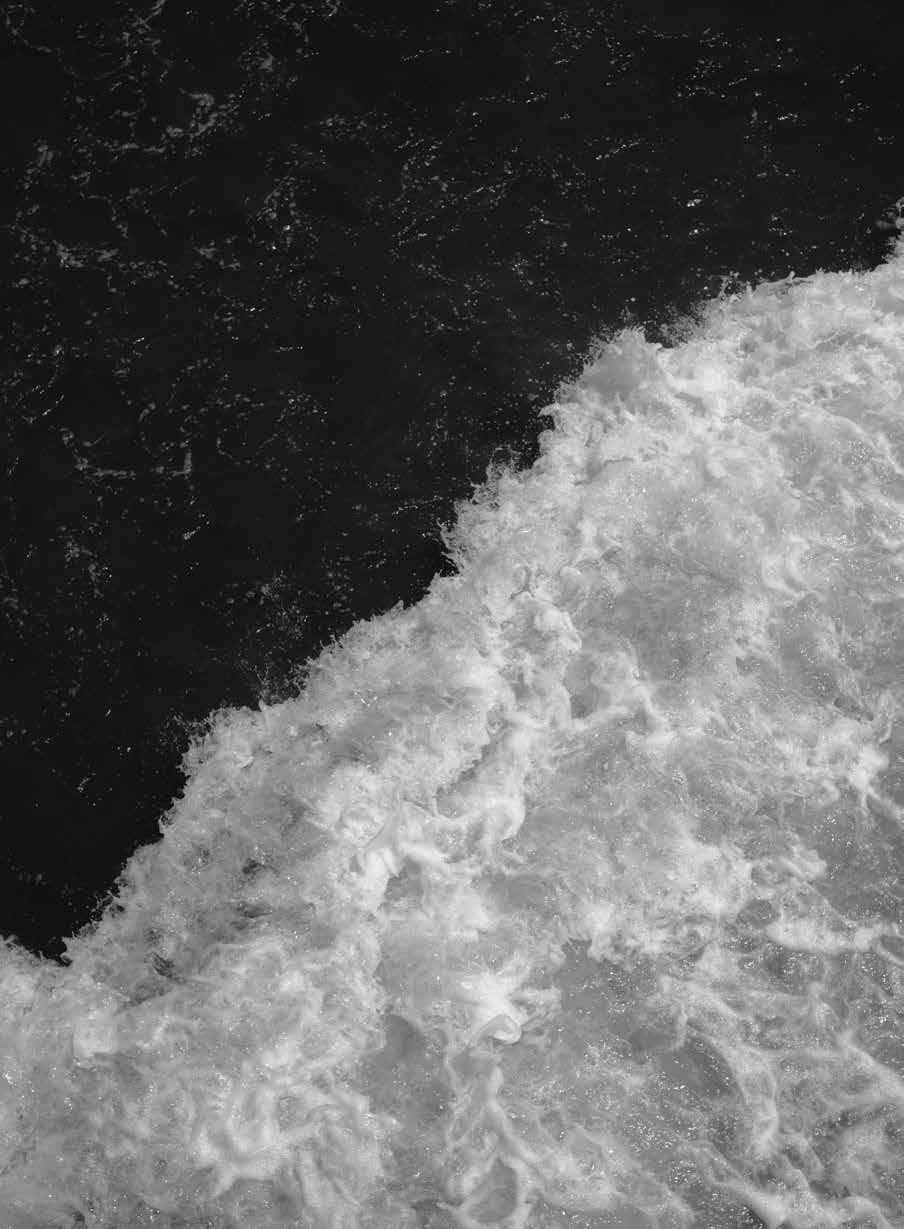 Season Eight
Season Eight


SUMMER SPLENDOR
Nestled between the Pacific Ocean and sprawling Los Angeles, Shutters on the Beach and Hotel Casa del Mar are the ideal Santa Monica base for experiencing a sun-filled vacation that blends Southern California beach lifestyle with the Los Angeles area’s finest art and entertainment. Here are just a few of our top recommendations:
BEACHSIDE BLISS
Kick off your summer along the 3.5-mile stretch of Santa Monica Beach, where ocean side paved walkways invite leisurely strolls and bike rides, and beachgoers can immerse themselves in swimming, water sports, picnics, sunset viewing and more.
Extend any beach day with an adventure at the iconic Santa Monica Pier. Dive into its fascinating history with a guided tour, experience the joy of Pacific Park’s solar-powered Ferris wheel, and soak up the vibrant atmosphere.
MUSIC AND SPORTS
Summer is always electrifying in Santa Monica and its surrounding cities. Culturally, 2024 is poised to be equally exhilarating.
Synonymous with Southern California’s warm summer nights are concerts under the stars at the Hollywood Bowl. In addition to the popular LA Philharmonic series led by conductor Gustavo Dudamel, ‘The Bowl’s’ season features a wide range of genres including classical, jazz, rock, pop, and world music.
Witness baseball virtuoso Shohei Ohtani’s inaugural summer with the LA Dodgers. Ohtani’s unique skill set as a two-way player landed him a record breaking $700 million dollar contract. His debut season at Dodger Stadium promises to be a historic event, drawing fans from around the world.
Opening in time for the 2024 NBA Season, basketball fans are looking forward the new Intuit Dome, the future home of the LA Clippers. Next door to Sofi Stadium, this state-of-theart arena is the masterpiece of Microsoft cofounder Steve Ballmer. It is set to redefine the basketball experience with innovative sustainable design, automated concession stands and the Halo Board—the largestever double-sided halo display in an arena.
CONTEMPORARY ART SCENE
Still basking in the glow of the wildly successful Frieze Art Fair at Santa Monica Airport early this year, art lovers will have no shortage of inspiration this summer.
At The Gagosian in Beverly Hills the “Jean-Michel Basquiat: Made on Market Street,” exhibition will focus on the works Basquiat produced during the artist’s prolific period in Venice, California.
At LACMA, the major retrospective “Ed Ruscha / NOW THEN” will also take a deep dive into Ruscha’s connection with Los Angeles. The exhibition includes Ruscha’s photos of L.A. streets and a reconstruction of his ‘Chocolate Room’—a sensory experience that features a room carved entirely from actual chocolate.
Recently installed In Santa Monica, the gigantic rotating head of David Lynch by Czech artist David Černý is a sight to behold. This five-ton animated sculpture is a tribute to the acclaimed film director and a fascinating fusion of public art and technology. Santa Monica, with its stunning coastline, vibrant arts scene, and proximity to Los Angeles’ sports arenas, is the ultimate summer destination. Get ready to experience the best of Southern California’s beach lifestyle and all the cultural riches the area has to offer.
Enjoy your stay!
–The Concierge Team
04
Tidings from ETC Hotels image by
Tim Aukshunas
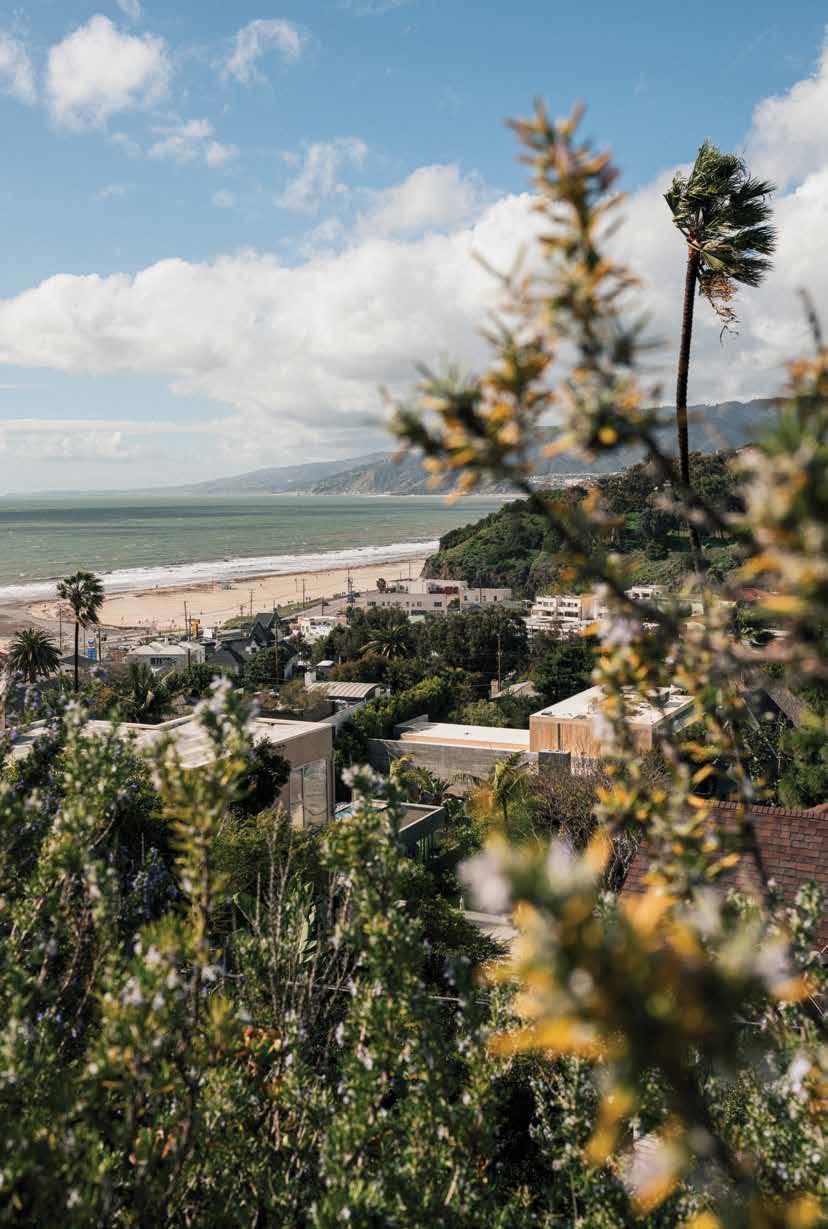

06 ABOUT THE COVER Image
table of contents REGENERATION 14 Golden Hour Grandeur 28 Santa Monica Canyon’s Architectural Gems WELLSPRING 42 Style, Sun and Sand: A Beach Fashion Shoot 60 Keyla Marquez: Style for Miles 64 Santa Monica Sustenance PEOPLE 72 Un-wine(d) by the Beach 84 Beach Reads FROM ETC HOTELS 90 A Coastal Culinary Dream 94 Seaside Spritzes
by Blake Abes. Santa
Monica
Beach, black and white.
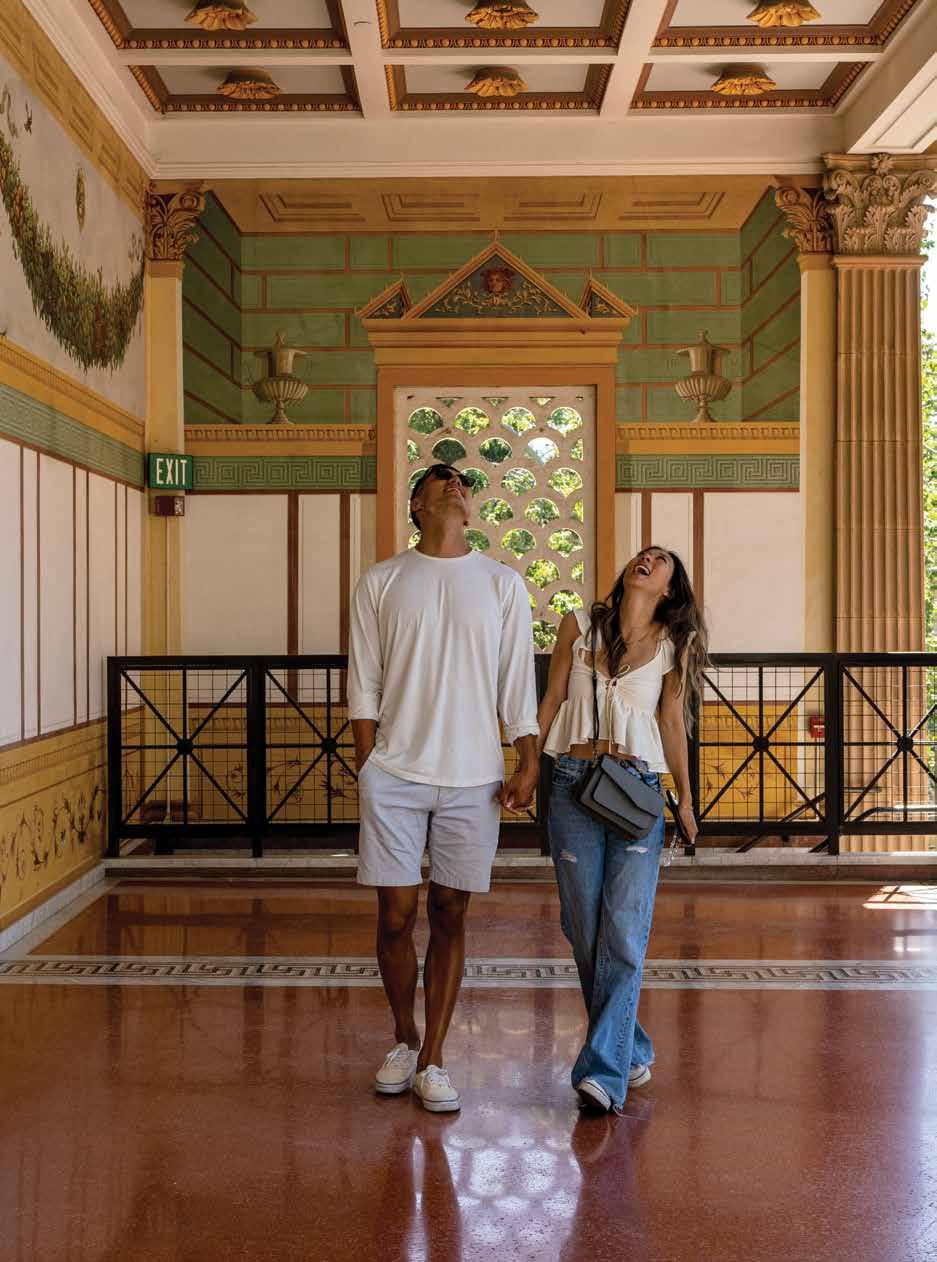
the ancient art,
Text and design © 2024 J. Paul Getty Trust FREE ADMISSION Plan your visit
Happy 50th to the Getty Villa Museum! Come celebrate with us as you explore the gardens, experience
and enjoy the ocean breeze.
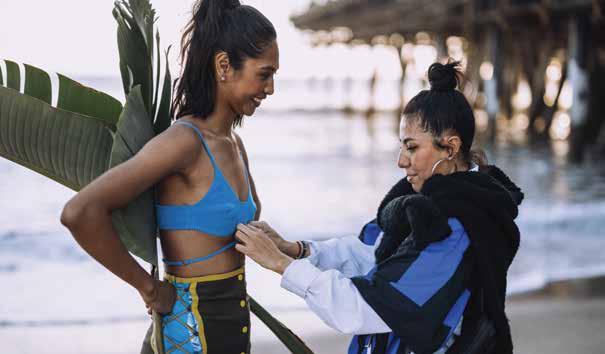
Instagram @hotelcasadelmar @shuttersca
Facebook /CasadelMar /ShuttersontheBeach
08 table of contents online WAVES TV: STYLE, SUN AND SAND Get a behind-the-scenes look at our beach fashion shoot. Watch every episode of Waves, catch up on original stories, and encounter new seasonal content online. waves.edwardthomasco.com SOCIALIZE WITH SHUTTERS ON THE BEACH AND HOTEL CASA DEL MAR
image by Tim Aukshunas

image by Tim Aukshunas
CEO & PUBLISHER
Jason Cutinella
GLOBAL EDITORIAL DIRECTOR
Brian McManus
EDITORIAL
CONTRIBUTING WRITERS
Armella Stepan
Anne Wallentine
CONTRIBUTING PHOTOGRAPHER
Tim Aukshunas
GLOBAL DESIGN DIRECTOR & CREATIVE PROCESS
Chelsea Vaccaro
CREATIVE SERVICES
Gerard Elmore VP FILM OPERATIONS
Merri Gruesser VP GLOBAL DEVELOPMENT & STRATEGIC OPERATIONS
Joe V. Bock CORPORATE AFFAIRS
Sabrine Rivera OPERATIONS DIRECTOR
ADVERTISING
Mike Wiley VP SALES mike@nmgnetwork.com
Claudia Silver VP GLOBAL PARTNERSHIPS claudia@nmgnetwork.com
Alejandro Moxey SENIOR DIRECTOR, SALES
Kristine Pontecha CLIENT SERVICES DIRECTOR kristine@nmgnetwork.com
Published by: NMG Network 41 N. Hotel St. Honolulu, HI 96817
©2024 by NMG Network, LLC. Contents of Waves are protected by copyright and may not be reproduced without the expressed written consent of the publisher. Waves assumes no liability for products or services advertised herein. Waves is a semiannual lifestyle publication of ETC Hotels.
10 masthead


image by
Pablo Enriquez
“
Lighting is the jewelry of the home... beautiful earrings that glow and can completely make a room.”
REGENERATION
What makes a quintessential California home?
Encapsulating dramatic, verdant slopes, breathtaking coastal views and liminal desert spaces, all in one state, the Californian landscape is a miracle of cosmic design. As such, many denizens of California have attempted to match the grandeur of its natural world in their personal living spaces.
There are few states like it in that regard— ones that have such a distinct personality and aesthetic that they’re instantly recognizable. What makes California interior design California? To some it’s the effortless elegance, the blending of casual comfort and sophistication, relaxed yet refined. Others may note the indooroutdoor living the climate invites, the use of natural materials, or sunlit spaces. There’s a Mid-Century Modern thread that runs throughout some California looks, while others embrace an eclectic mix of styles and cultural influences—Spanish, Mediterranean, Asian, and Scandinavian.
To help answer this question, we looked to two designers working at the top of their game in Los Angeles. Their work with private clients and businesses exude a California cool that’s unmistakable.
Tyka Pryde Edwards of Tyka Pryde Interiors, and Tiffany Howell, founder of L.A. design firm Night Palm, both have their own ideas and tips about capturing the magic of the Golden State at home.
Edwards is a visionary interior designer and style icon known for her innovative flair and trendsetting designs. With a rich background in television production design, including eight seasons as Art Director on Queer Eye, she’s collaborated with top networks like HBO Max, Amazon, and HGTV. In 2022, she launched her own design firm, catering to both private and commercial projects with a collaborative approach. Her passion for interiors and set design, cultivated in film school, has led Edwards to transform countless homes, restaurants, and television sets worldwide, curating spaces that authentically reflect her clients’ personalities and aspirations.
With Night Palm, Tiffany Howell has become a renowned American designer celebrated for her lush, moody interiors that merge fashion, music, and storytelling. With expertise in high-end residential, commercial, and retail spaces, Howell’s
Grandeur images by
Golden Hour
text by Suzy
14
Tim Aukshunas and Pablo Enriquez
Exposito
Tiffany Howell’s project in Koreatown, “Hemingway’s Mistress.” The mood board she asked the owners to create featured images of the Chateau Marmont in fog. A vintage Steve Chase sectional and a ’70s marble coffee table anchor the living room. Image by Pablo Enriquez.
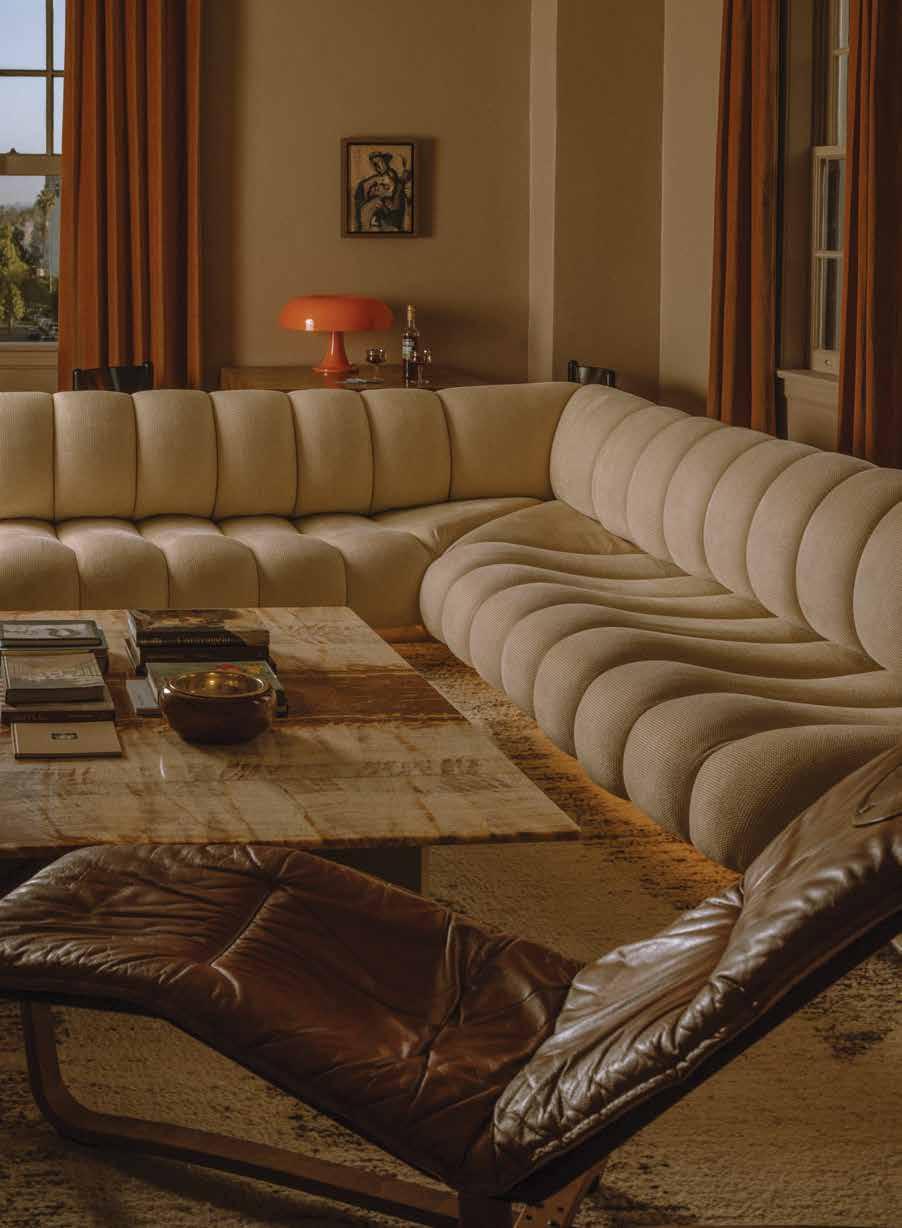
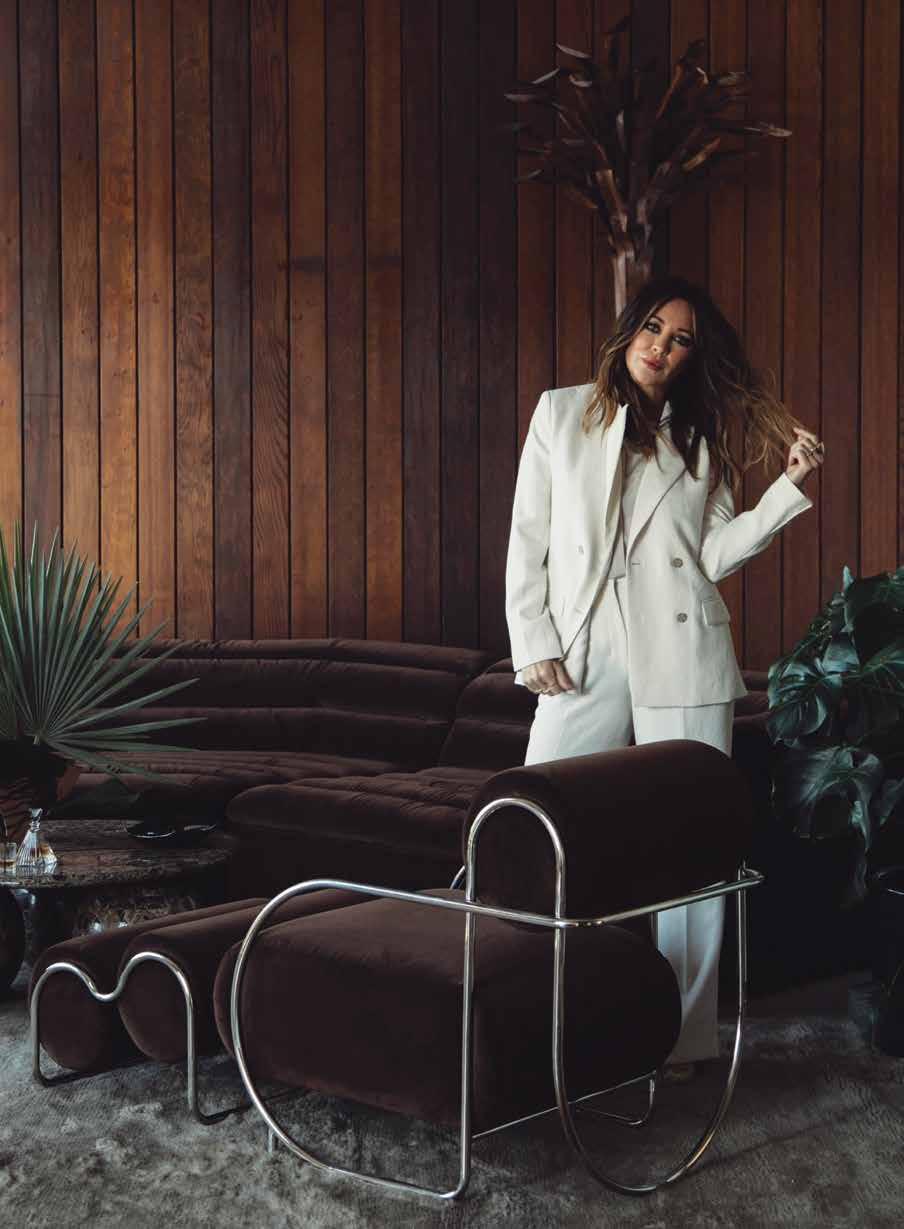
 Left: Tiffany Howell, the Principal of design firm Night Palm, strikes a pose. Above: Howell’s “Lovers Rock” project in Los Feliz. Next Page: The living room at Lovers Rock. Images by Pablo Enriquez.
Left: Tiffany Howell, the Principal of design firm Night Palm, strikes a pose. Above: Howell’s “Lovers Rock” project in Los Feliz. Next Page: The living room at Lovers Rock. Images by Pablo Enriquez.
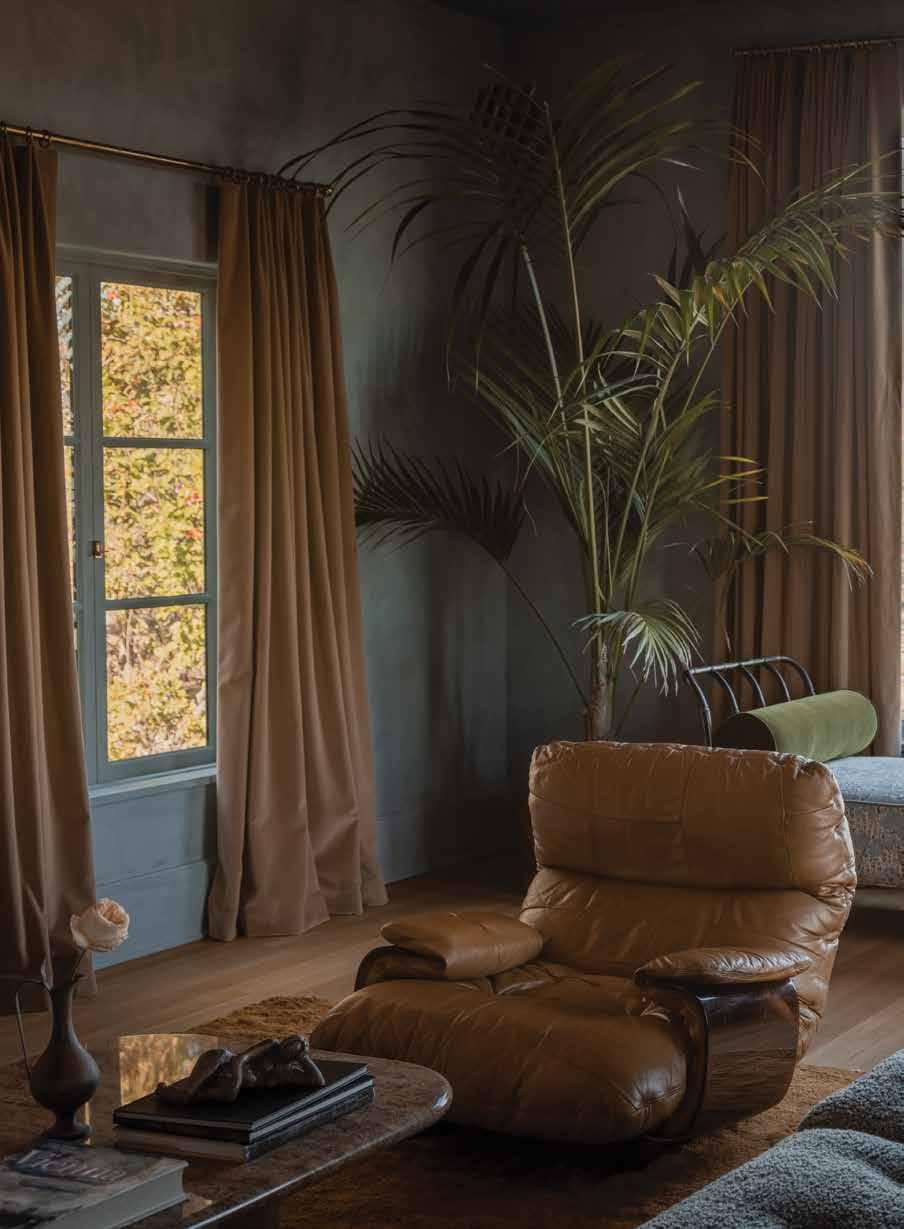
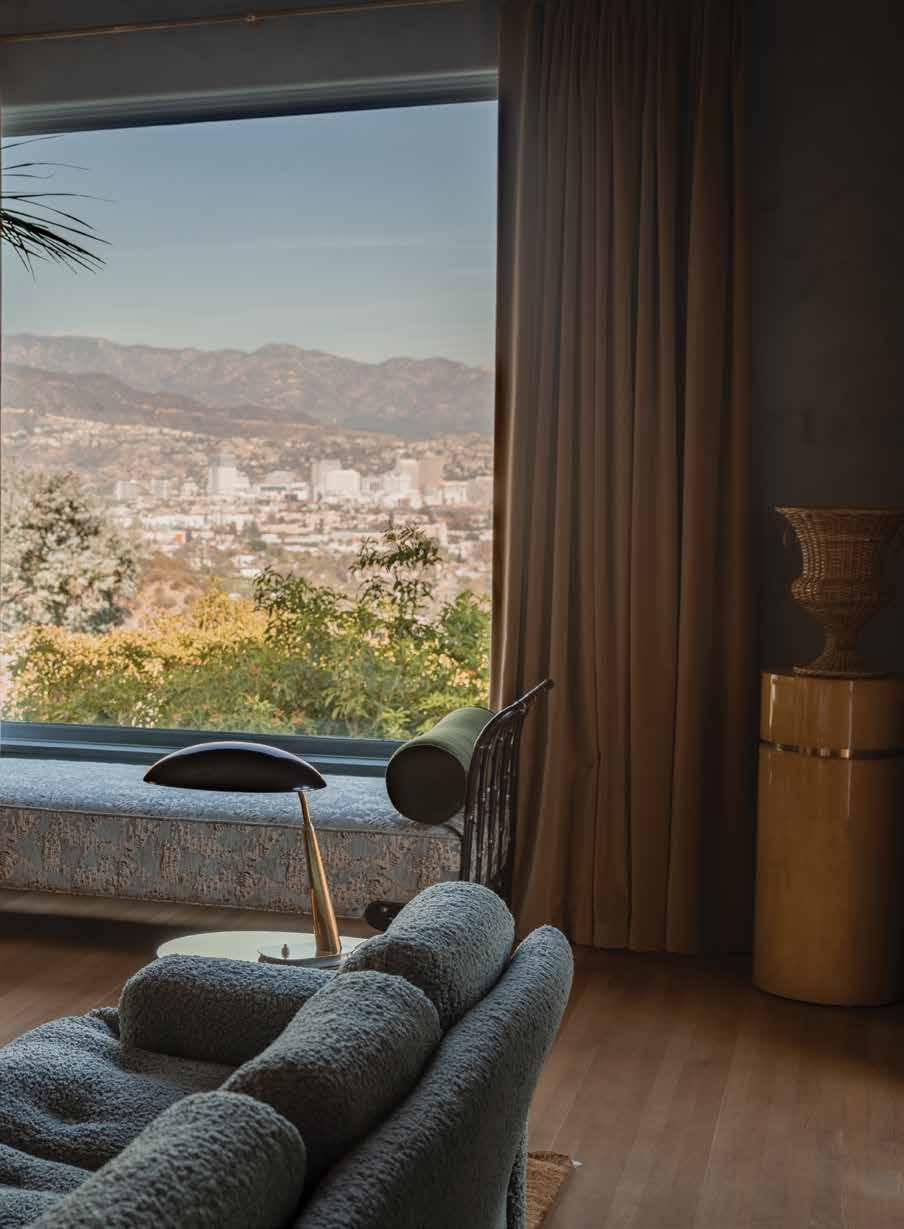
background spans directing, styling, and production design. Her signature aesthetic blends vintage European furniture with modern elements, creating spaces that evoke emotion and transport individuals through time. Named an Elle Decor A-List designer, her latest venture includes the design of the West Hollywood location of the iconic Parisian restaurant, Caviar Kaspia.
The first step to designing a quintessential California space, says Edwards, is “bringing the outside inside.”
Originally hailing from New Hampshire, Edwards headed west to integrate more sunshine into her daily life. Now based in Hollywood, she’s found inspiration well beyond the star-studded Walk of Fame, and combines earth-sourced materials with metallic accents and vibrant splashes of pop-art colors. “California has this spirit of innovation,
creativity and inclusivity,” she says. “And through my work, I try to channel the spirit of that into my spaces—its diversity of mountains, oceans [and] deserts. Using materials like wood, stone, linen and other woven textures, helps create this organic, rustic elegance. I love to add skylights when I can, because natural lighting plays a big role.”
Howell echoes the importance of natural light; after all, she declares, it’s one of L.A.’s greatest assets.
“Lighting is the jewelry of the home,” she says. “It’s these beautiful earrings that glow and can completely make a whole entire room, but also can light my clients to look beautiful. I think about how my clients’ skin tone looks against the wall colors. How would they wear the light? I’m a golden hour, driving down SunsetBoulevard kind-of-girl,” Howell says. “That’s
20
“Caviar Kaspia” design by Tiffany Howell. Image by Pablo Enriquez.
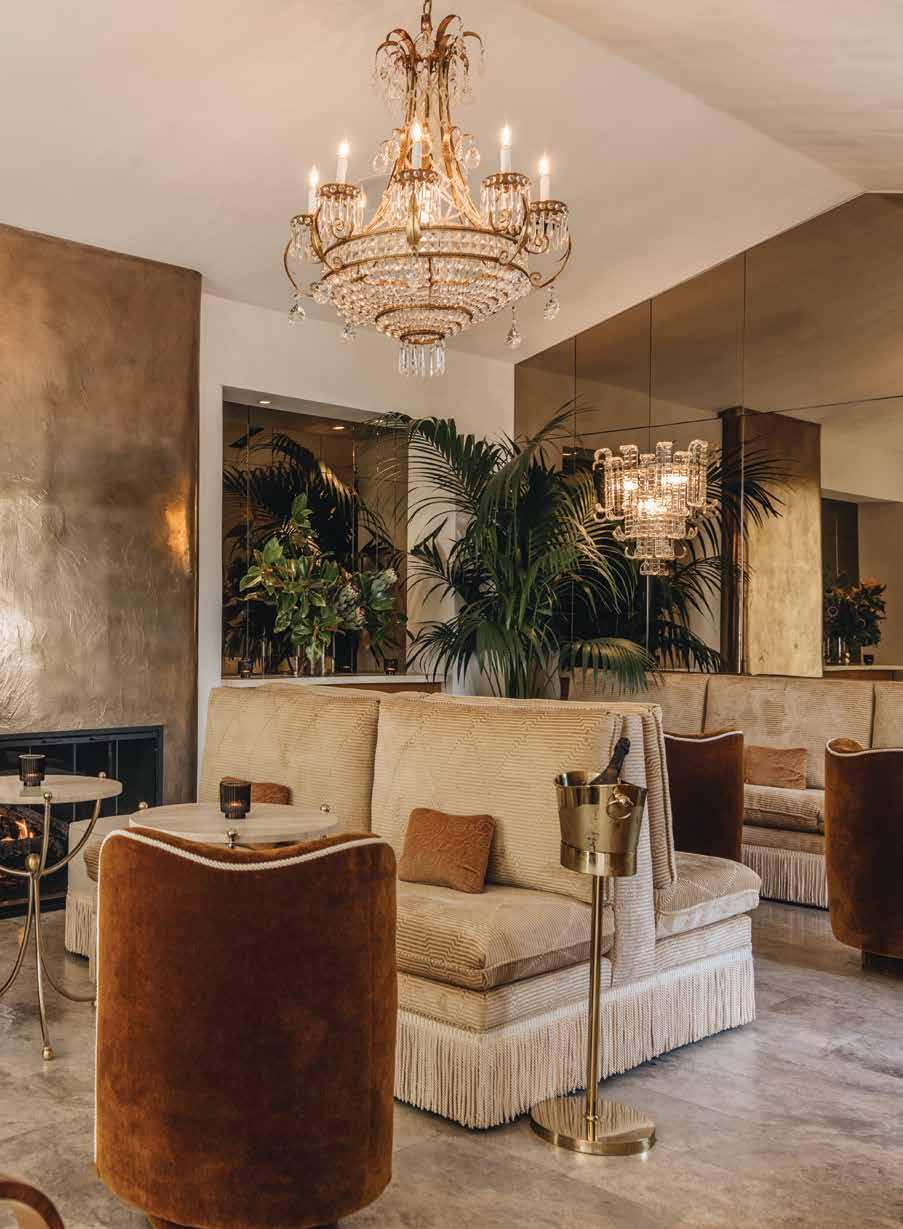
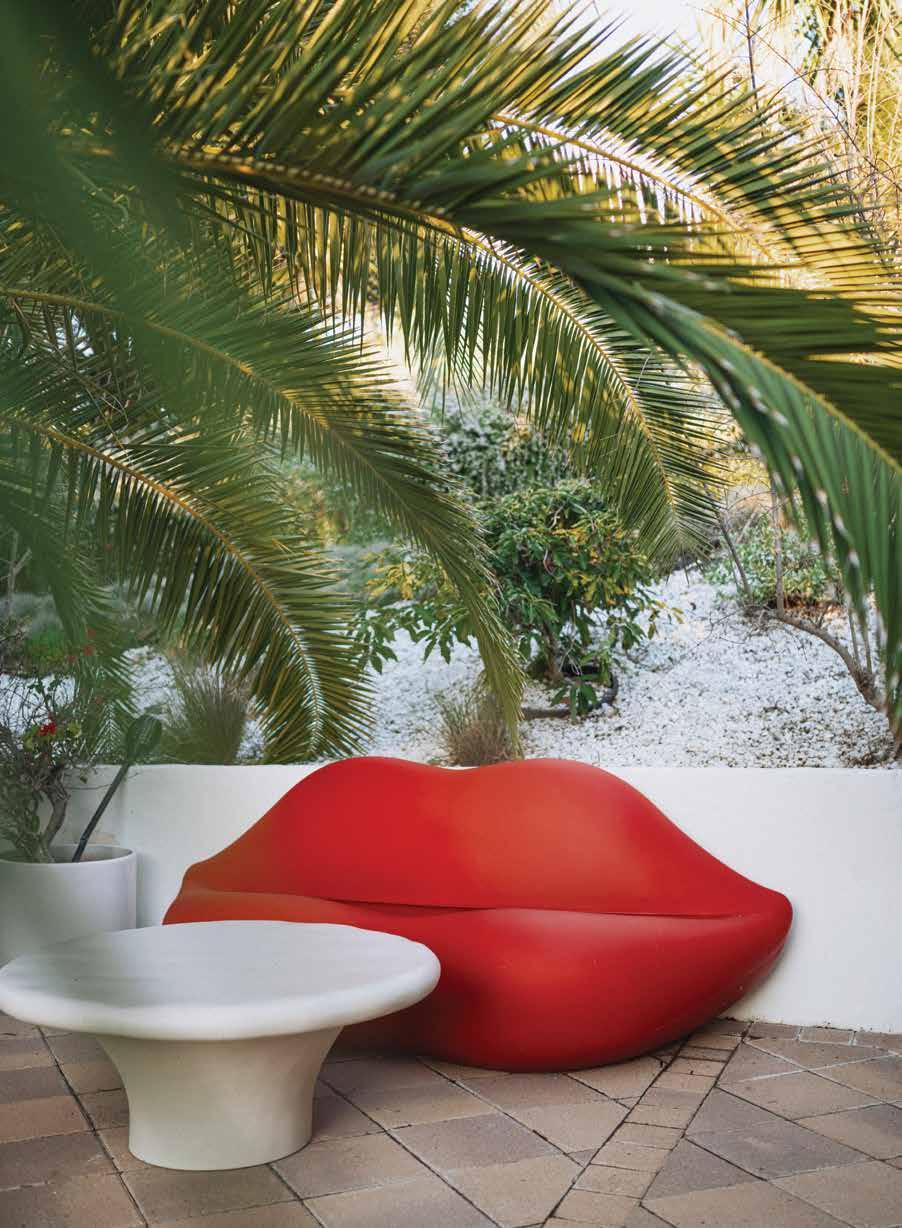
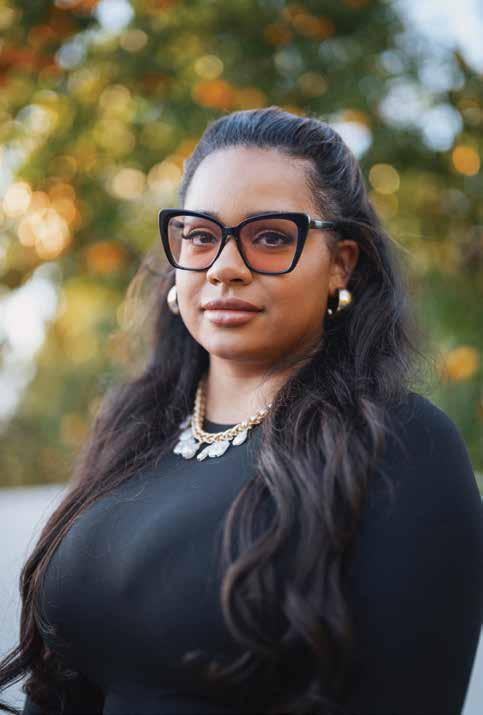 Left: A playful couch sets the tone of a Woodland Hills home designed by Tyka Pryde Edwards. Above: Designer Tyka Pryde Edwards. Images by Tim Aukshunas.
Left: A playful couch sets the tone of a Woodland Hills home designed by Tyka Pryde Edwards. Above: Designer Tyka Pryde Edwards. Images by Tim Aukshunas.


my California color palette: a warm, late afternoon glow, but a little washed out.”
Having once produced videos for Britney Spears and Jennifer Lopez, Howell also recommends starting projects with a song in order to accurately assess the mood of a room. The sounds of Leonard Cohen, Lana Del Rey and the Velvet Underground have all inspired the dusky, rock ‘n’ roll romance that imbues Howell’s spaces. “I kick off every project with a soundtrack,” she says. “You start with the feeling, then you lean into the aesthetic.”
Now in her ninth season of Queer Eye, Edwards observes that the arid, open layouts she sees in many California homes—perhaps a reflection of the state’s vastness—is not suitable for everyone’s needs. “People want walls to create more intimate moments within their home, and to give each room more personality. For a roomy California
home, I’d recommend dividing the space and going maximal with textures and layers — brown wooden slats and ceiling tiles make great details, and give it that beachy feel.”
Howell, who splits much of her time between Silverlake and Italy, takes inspiration from vintage fashions by Yves Saint Laurent, as well as ancient art history, to introduce more personal touches into the scenery. “I love raw and lacquered brasses,” she says. “I use a lot of lime wash and Roman clay on the walls, which is natural. I love a living finish that patinas over time, and doesn’t feel so phony.
“Using natural materials never goes out of style,” Howell adds. “You want things to look like they have a soul!”
That makes sense. Afterall, soul and style are two things California has in abundance.
26
Pg 24-25: The cozy living room of Tyka Pryde Edwards’ Woodland Hills residential project.
Right: A layered bedroom utilizes light and darker shades for a stunning California contrast. Design by Edwards. Images by Tim Aukshunas.
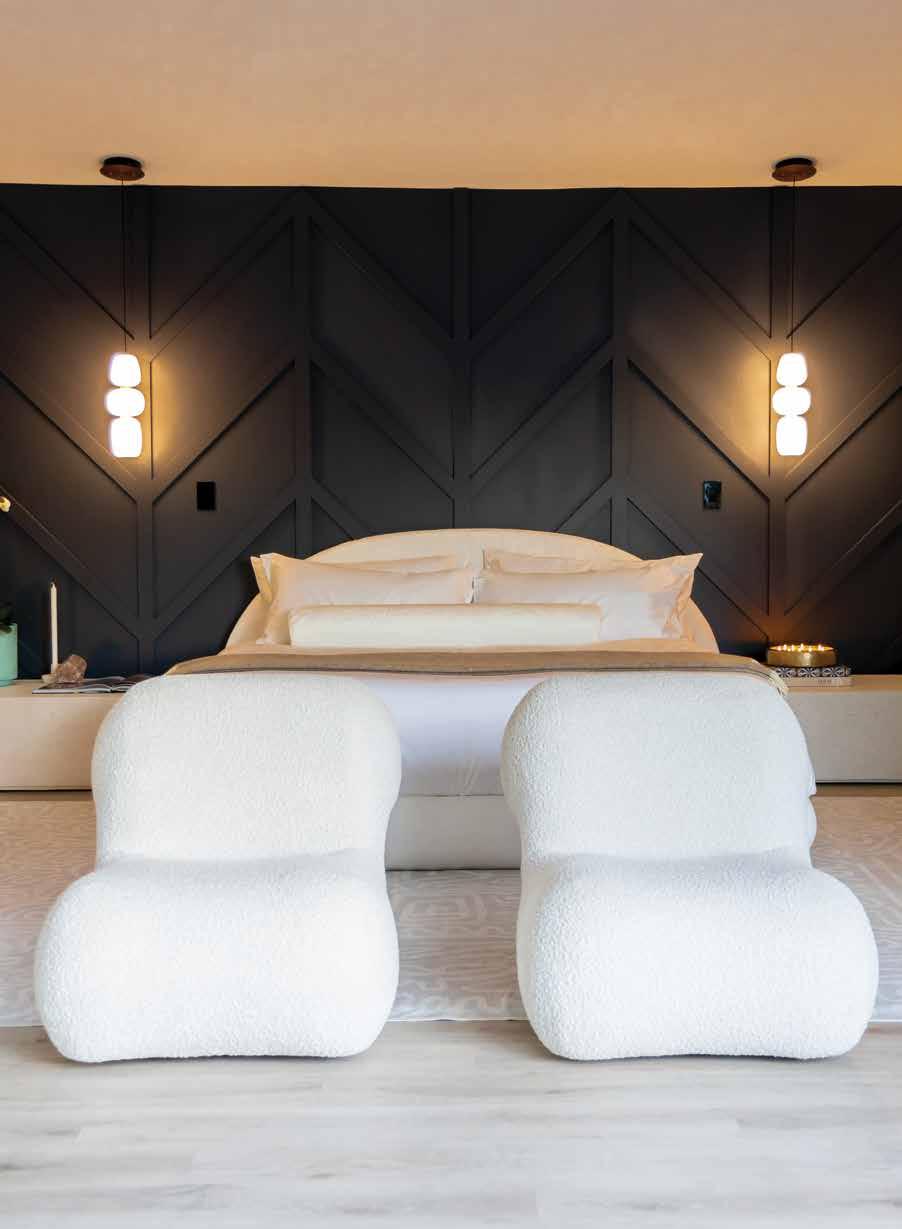
The area’s eclectic homes include everything from Tudor houses to contemporary bungalows.
Santa Monica Canyon—a swanky, secluded neighborhood nestled between the bluffs of Santa Monica and the Pacific Palisades—is dotted with architectural gems. But long before its residential iteration, the canyon’s lush landscape served as rural rancho land and bohemian beach enclave…with some Hollywood stars thrown in. Today, its eclectic architecture includes everything from Tudor houses to contemporary bungalows, revealing both the area’s history and the influence of famed modernist architects that include Richard Neutra, Ray Kappe, Lloyd Wright, Charles Moore and Craig Ellwood.
The canyon was first colonized via Mexican land grants. In 1839, the Mexican government granted the Marquez and Reyes families the 6,656 acres of Rancho Boca de Santa Monica, which included Santa Monica Canyon, parts of the Palisades, and Topanga. “Thinking of 1849 when this very, very valuable real estate was just grasslands is very, very amazing to me,” says Colleen McAndrews, a local resident and attorney who worked with Marquez descendants to preserve the family’s cemetery in the canyon. Though none of the early adobe houses remain, the footprint of the first Marquez home—believed to be the
first permanent structure in the canyon— is marked out in the family’s private plot. American settlers soon followed, bringing new architectural styles to the landscape as it was divided and sold off by its inheritors.
Adelaide Drive runs along the Santa Monica side of the canyon, with sweeping views over it and the ocean. The homes there, some clinging to the edge of the palisade, provide a stroll through architectural history. The son of Senator Jones, one of the modern city’s founders, built the turn-of-the-century Colonial Revival home that is now known as the Second Roy Jones House at 130 Adelaide. Just down the street, the Millbank House embodies the classic California Craftsman ideals of handmade workmanship and natural materials. Further on, architect Frank Gehry’s contemporary home is sustainably-heated, wood-beamed, and glass-paneled—and represents a marked evolution from his first, avant-garde house on 22nd Street, which was made of corrugated metal, glass, and chain-link fencing.
Even beyond Adelaide, the canyon’s mix of construction represents a wide range of regional styles: French Provincial, mock
Santa Monica Canyon’s Architectural Gems
28
The Zuni House at 710 Adelaide Place. Built in 1926, this landmark draws inspiration from two of the revival styles popular in the 1920s—Pueblo Revival and Mayan Revival.
images by Tim Aukshunas text by Anne Wallentine


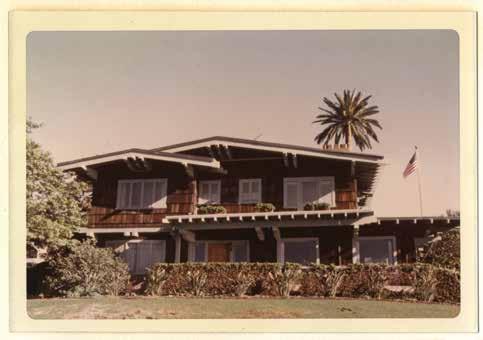 Above and right: The Millbank Home, then and now, located at 236 Adelaide Drive. The Craftsmanstyle home was commissioned in 1911 by wealthy Los Angeles resident, Isaac Milbank. It was designed by the Milwaukee Building Company. The home is a City of Santa Monica landmarked structure.
Above and right: The Millbank Home, then and now, located at 236 Adelaide Drive. The Craftsmanstyle home was commissioned in 1911 by wealthy Los Angeles resident, Isaac Milbank. It was designed by the Milwaukee Building Company. The home is a City of Santa Monica landmarked structure.
Tudor, and Spanish Mission—like architect John Byers’ sprawling, landmarked Spanish Colonial Revival Bradbury House, built in 1922 on Ocean Way. The unique Mayanand Pueblo-inspired Zuni House nearby shows the ways these historic styles were romanticized and adapted to the Southern California landscape in the 1920s.
In this period, the canyon began evolving into a freewheeling artists’ and writers’ colony. The 1930s were “a magical time here,” McAndrews says. “It was very much a beach community with small lots and small houses, by and large…It was very bohemian. There were a lot of artists and Hollywood people,” drawn by the landscape and its (then) affordability.
There are no stars lining the sidewalks, but Hollywood legends still linger in the quiet streets. The canyon was home to early movie star Leo Carrillo as well as actress Dolores del Rio and her husband, MGM art director Cedric Gibbons. Silent movie star Ramon Novarro inhabited the Second Roy Jones House for a time, while producer Louis B. Mayer, co-founder of Metro-GoldwynMayer (MGM), owned a vacation home on Ocean Way. Mexican tenor Jose Mojica’s home hosted numerous parties during his ownership and, later, that of Dr. Clifford Loos. Dr. Loos’ sister, screenwriter Anita Loos of
Gentlemen Prefer Blondes fame, brought writer friends like Aldous Huxley to visit.
Screenwriter Salka Viertel’s European-style cottage at 165 Mabery Road was another hotspot for the era’s leading artists and intellectuals as she hosted the German émigré community fleeing Nazi repression. Her famed salon included actresses Greta Garbo and Tallulah Bankhead, playwright Bertolt Brecht, and director Billy Wilder. Viertel’s home was later owned by director Gordon Davidson and his wife Judi. McAndrews relates that a young, “brand new architect who didn’t have a lot of work” redid their garage: Frank Gehry. (The practical structure did not reflect his idiosyncratic mature style.)
Writer Christopher Isherwood also orbited the canyon’s literary and celebrity circles, living in several local homes before settling on Adelaide Drive with his partner, artist Don Bachardy. Isherwood enshrined the canyon’s topography and status as an immigrant and LGBTQ+ haven in his 1964 novel A Single Man, where he characterized it as “a subtropical English village with Montmartre manners: a Little Good Place where you could paint a bit, write a bit, and drink lots.” Its residents, he wrote, “saw themselves as rear-guard individualists, making a lastditch stand against the twentieth century.… They were tacky and cheerful and defiantly
32
A home on Adelaide Drive, overlooking the canyon, with views of the ocean.
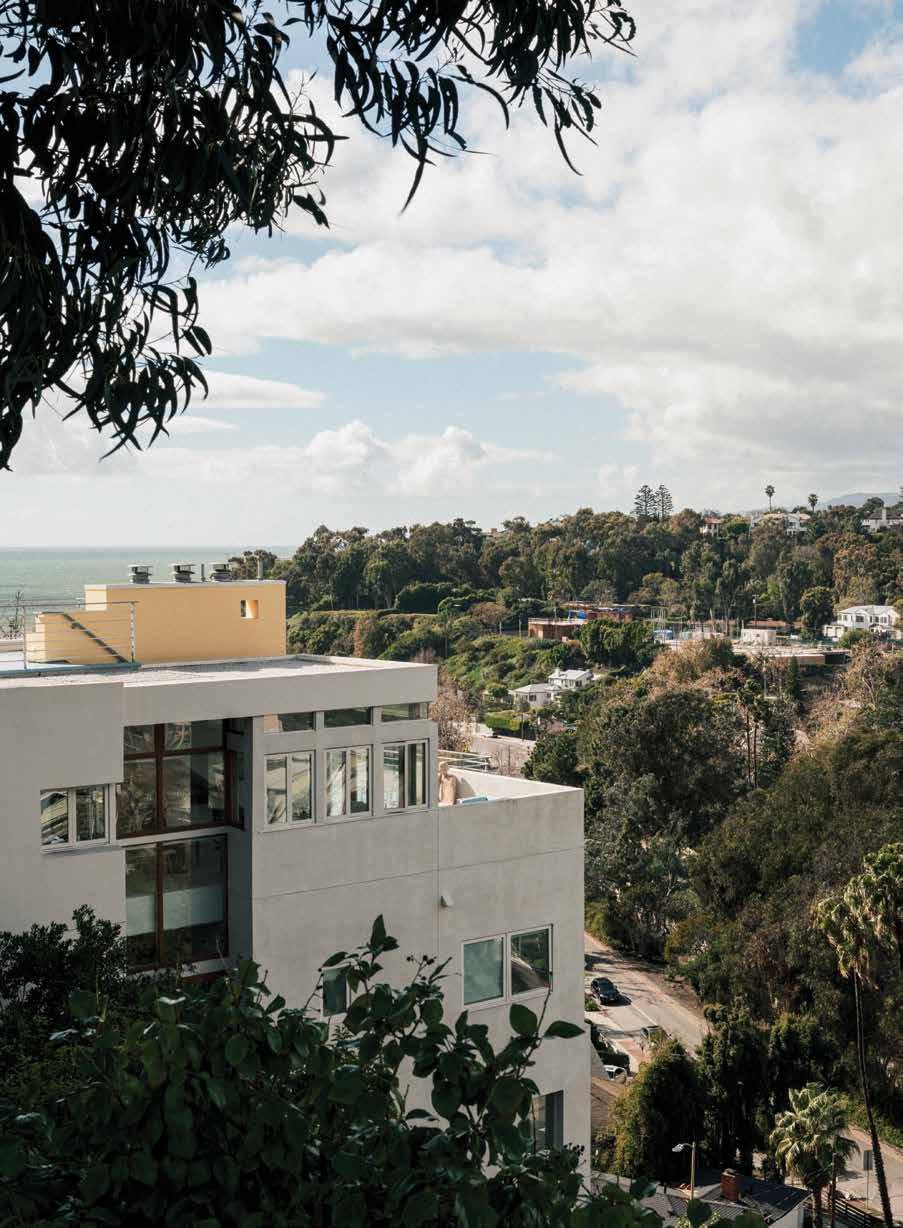
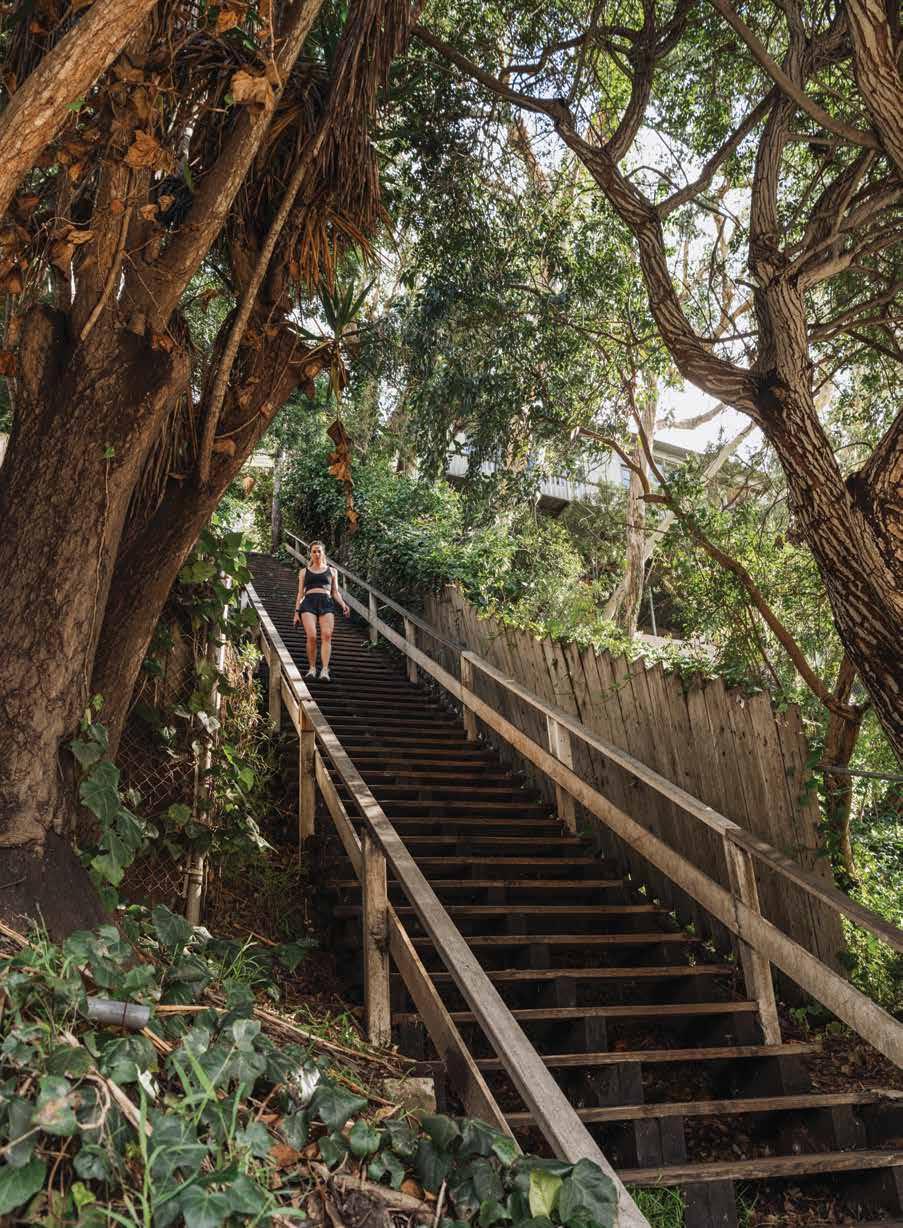
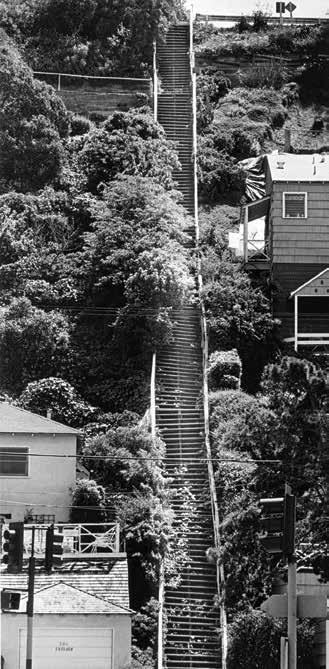 Above and left. The famed Santa Monica Stairs, today and in 1978. The wooden stairs at 380 Entrada Drive in Santa Monica Canyon ascend to Adelaide Drive
Above and left. The famed Santa Monica Stairs, today and in 1978. The wooden stairs at 380 Entrada Drive in Santa Monica Canyon ascend to Adelaide Drive
bohemian, tirelessly inquisitive about each other’s doings, and boundlessly tolerant.”
After World War II, the canyon’s terrain provided an ideal canvas for the experimentation of the midcentury modern Case Study architects. Five innovative homes were designed on a parcel on Chautauqua Boulevard for the program dreamed up by Art and Architecture magazine’s publisher John Entenza, serving as ‘case studies’ to meet modern needs and soaring post-war demand. These included the Eames House by famed, married designers Charles and Ray, the Entenza House, designed by Charles Eames and Eero Saarinen, and the West House by Rodney Walker. Entenza was already familiar with the neighborhood, having lived on nearby Mesa Road in a Streamline Moderne home he commissioned from Harwell Hamilton Harris in 1939.
Modernist architects continued to colonize the canyon: Thornton Abell, another Case Study architect, built a home on Amalfi Drive, while Richard Neutra left his thumbprint on several lots. Neutra designed the Sten Frenke House at 126 Mabery Road as well as family homes at 491 and 302 Mesa Road, the latter moved there in the 1960s from a previous site. Ray Kappe, founder of the Southern California Institute of Architecture, built homes on Hilltree and Latimer Roads: one a streamlined, set back wood-and-glass treehouse, the other replete with towering
steel and concrete curves. The Charles Moore Foundation now preserves the architect’s Burns House on Amalfi Drive, with its sunset palette and dramatic music room.
Resident and real estate agent Frank Langen says his first impression of the canyon in childhood was of its wooded, almost rural nature. The neighborhood was “built within these large sycamore trees, and they really dominated the whole experience beyond the architecture,” he recalls. It’s not for nothing that part of the area is still called Rustic Canyon (though the distinctions between the two canyons, and the ‘upper’ and ‘lower’ canyons, are often elided outside of locals and real estate listings). The neighborhood’s architecture is necessarily responsive to the canyon’s slopes—including the “secret stairs” that traverse some of the palisades between streets. Today, one set that runs from Adelaide to Entrada Drive is a popular exercise spot.
The canyon continues to be a “hotbed” of “famous artists, writers, and architects,” Langen says. Its topography “makes it difficult for developers, so it still appeals to individuals that are creative.” New construction continues the canyon’s architectural evolution, alongside efforts to preserve some of the historic structures. A new generation of affluent residents is already shaping the next era of the canyon’s history. They are, Langen says, “the lucky stewards of one of its chapters.”
36
 A 1920s Neo-Islamic style period home at 29 Latimer Road.
A 1920s Neo-Islamic style period home at 29 Latimer Road.
A CULINARY ADVENTURE IS ON THE HORIZON
Resting directly on the sand in Santa Monica, Shutters on the Beach and Hotel Casa del Mar are home to six memorable culinary destinations. Endless ocean views complemented by seasonal menus, craft cocktails, and live music nightly.
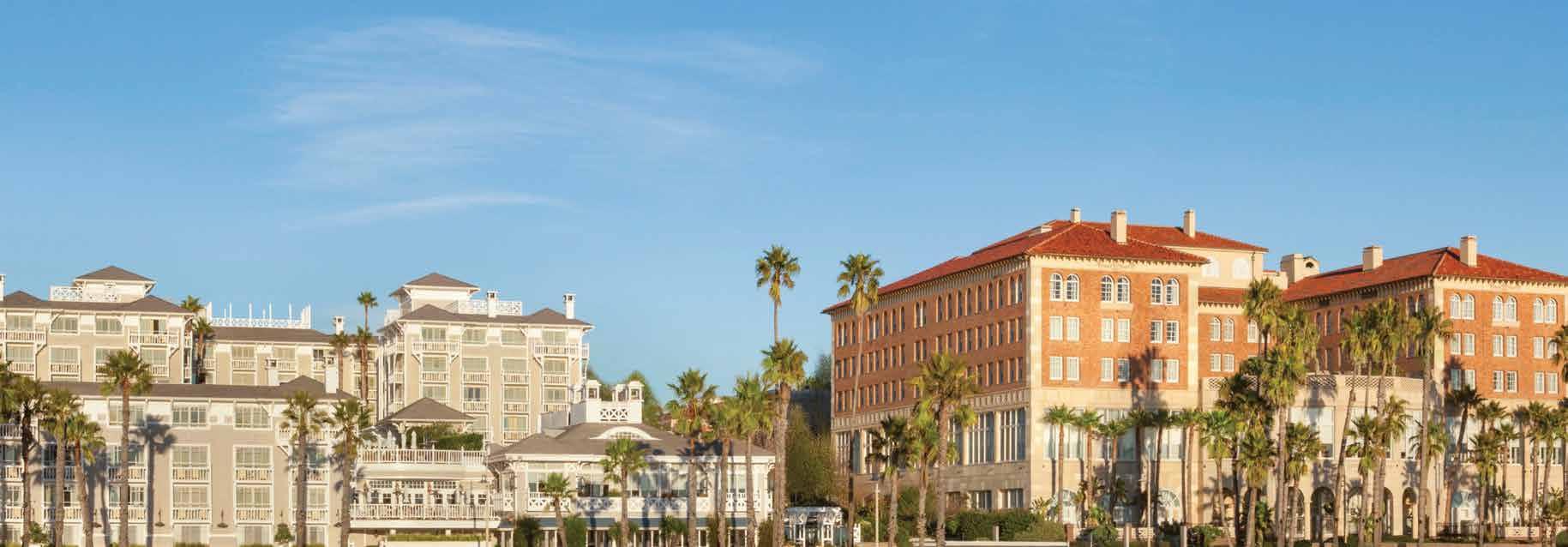
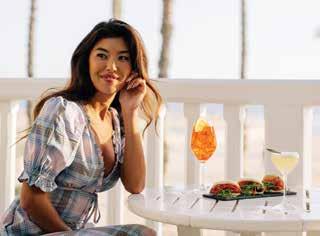

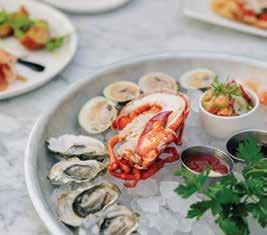
A luxuriant day-to-night space serving morning coffee, light meals, afternoon tea, or a night cap and live music. Linger by the fireplace or enjoy breathtaking Santa Monica sunsets from the best seat in town.
Santa Monica’s premier beachfront dining destination. Whether oceanfront or in the al fresco Courtyard, enjoy Chef Sean Runyon’s simply grilled coastal cuisine prepared with the finest ingredients from around the world and the local Farmers Market.
Relax and enjoy seafood forward California inspired dishes from Chef Vittorio Lucariello at Coast, a family friendly, casual environment to enjoy great food and picturesque views of the Pacific.

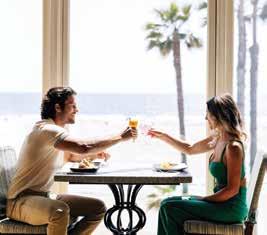
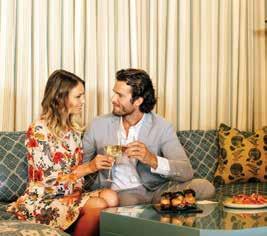
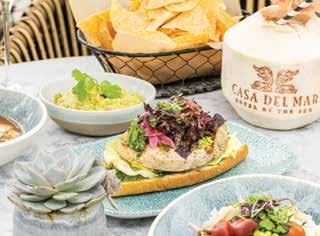


An unforgettable oceanfront dining experience where California cuisine meets Mediterranean traditions. Fresh seafood, handmade pasta and meticulously sourced ingredients by Chef Chad
The hottest luxe meeting spot in Silicon Beach, serving after-work cocktails, live entertainment, and light bites. Reserve a cabana for a day of work or a creative retreat.

Experience the seasonal charm of Patio del Mar, Casa’s al fresco bistro. With front-row, beachside seating, it’s the ideal spot for summer lunch or sunset dinner with friends. Sip refreshing cocktails or select from a curated wine list as you savor coastal cuisine and ocean views.
Huff.
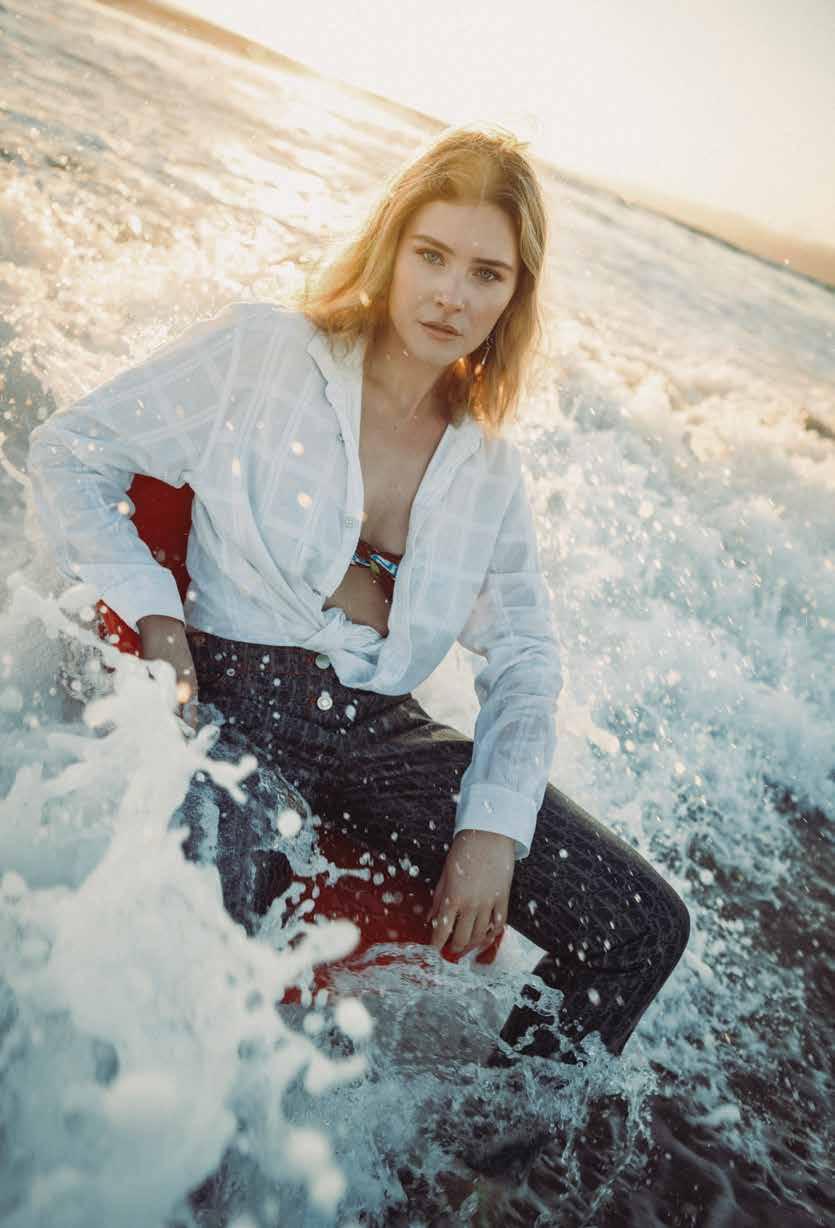
image
by Tim Aukshunas
“
We can make it luxe, but we can make it relatable.”
WELLSPRING
A harmonious blend of old and new, luxury and accessibility, all against the breathtaking backdrop of the Pacific.
The assignment wasn’t simple: pick a diverse range of luxury brands and local designers that will showcase what beachgoers might wear this summer. And make it fabulous. Luckily for us, Keyla Marquez was up to the task.
As Fashion Director at LA Times’ IMAGE Magazine (read more about Marquez and her background on page 60), she pulled not only the coolest in couture, but looks from some of the hottest up-and-comers in Los Angeles’ bustling fashion scene. From swimsuits to accessories, each of the looks comes together under the azure skies and against the backdrop of rolling waves at Santa Monica Beach, down the sand from
the famed pier and just behind Shutters on the Beach and Hotel Casa del Mar.
In it you’ll see looks from legacy luxury brands like Ferragamo, Prada, Fendi and Dior alongside pieces from Dries Van Nolen, Issey Miyaki, Jacquemus and Acne Studios.
In Marquez’s vision, diversity and texture reign supreme. And through her expert curation, we witness a harmonious blend of old and new, luxury and accessibility, all against the breathtaking backdrop of the Pacific. Join us as we embark on this journey of style, where fashion meets fantasy, and the beach becomes our runway.
Style, Sun and Sand: A Beach Fashion Showcase styled by
42
by Tim
Keyla Marquez
images
Aukshunas
Trench belt dress by Prada - $3500
Oversize sunglasses by Burberry - $280


 Shirt and pant by Ferragamo, Shirt$1190; Pant - $990
Men’s GG Gucci Slides Sandal - $550.
Shirt and pant by Ferragamo, Shirt$1190; Pant - $990
Men’s GG Gucci Slides Sandal - $550.

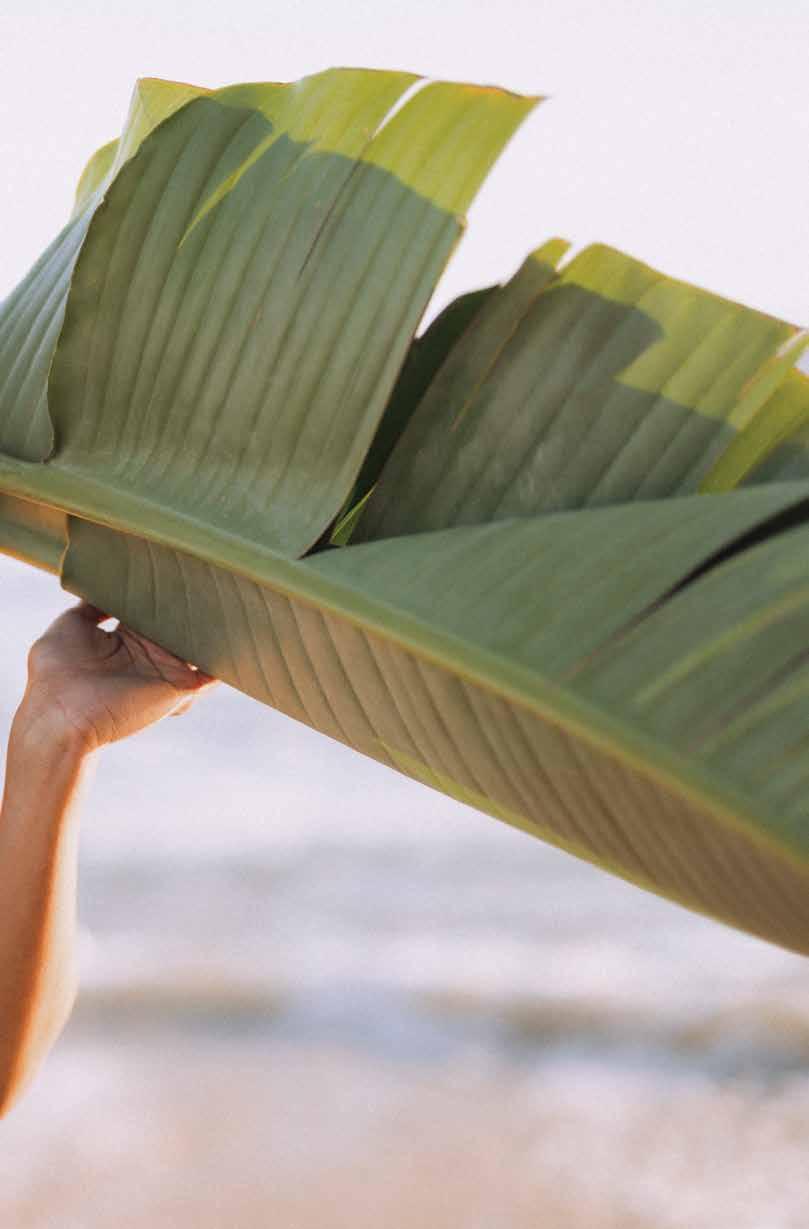
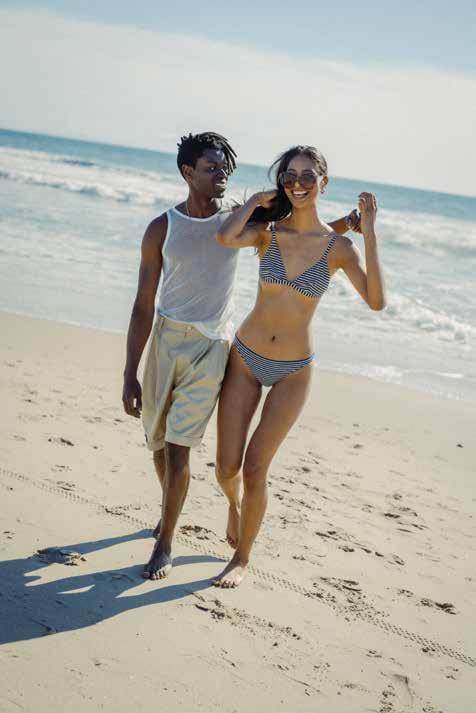 Right: Knit Missoni bikini - $590; White pinstripe Loewe blouse, $2100. Visor, blue clear Dior J’Adior - $225
Left: Dries Van Noten Tank - $520; Versace Chino shorts - $1125. Tory Burch bikini.
Right: Knit Missoni bikini - $590; White pinstripe Loewe blouse, $2100. Visor, blue clear Dior J’Adior - $225
Left: Dries Van Noten Tank - $520; Versace Chino shorts - $1125. Tory Burch bikini.
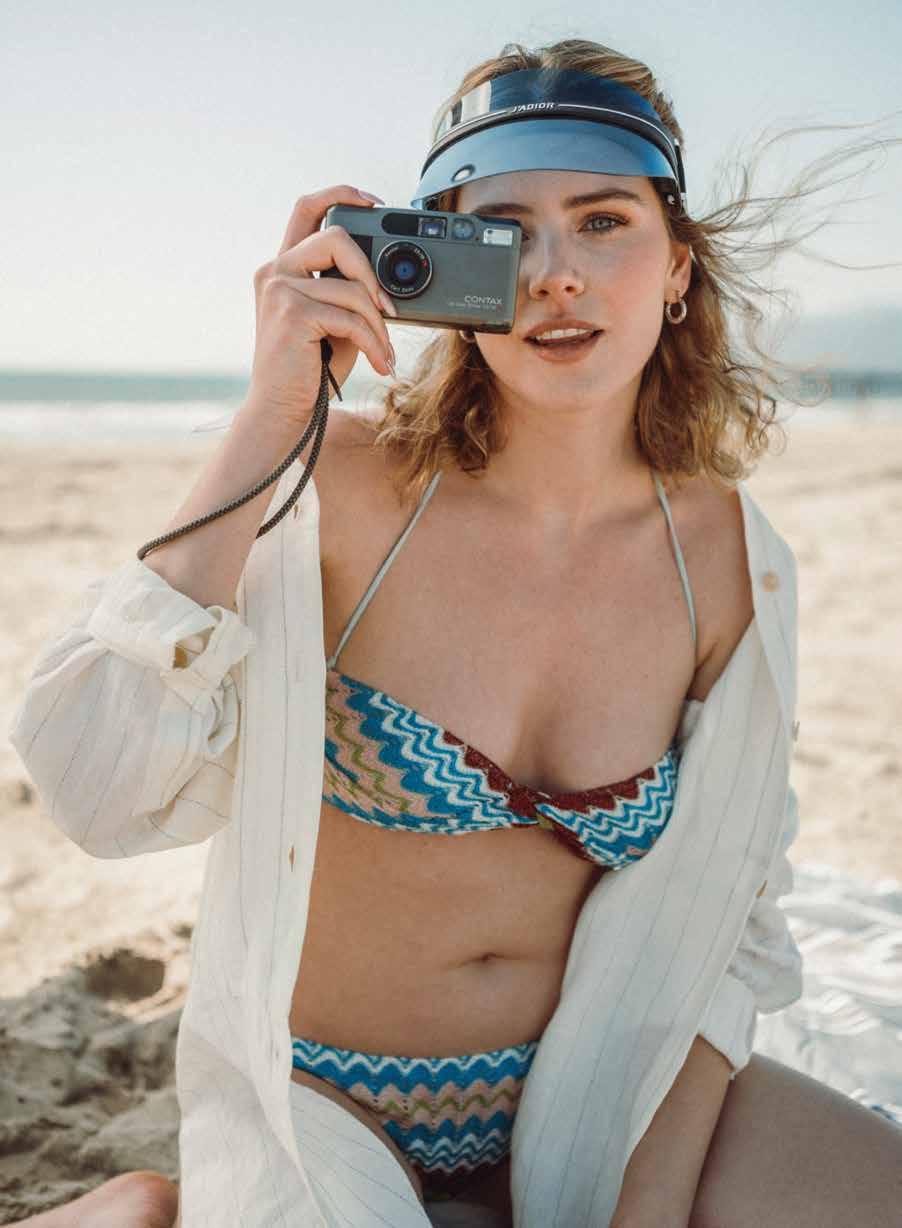
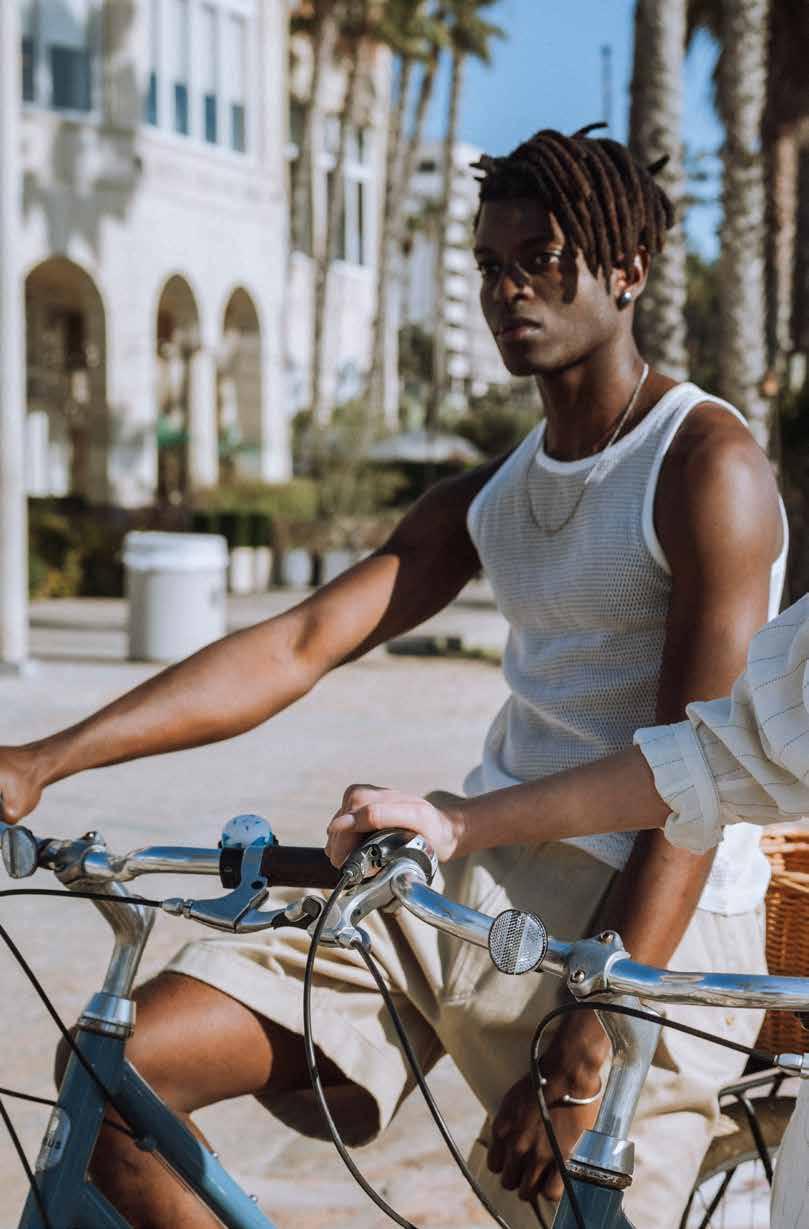


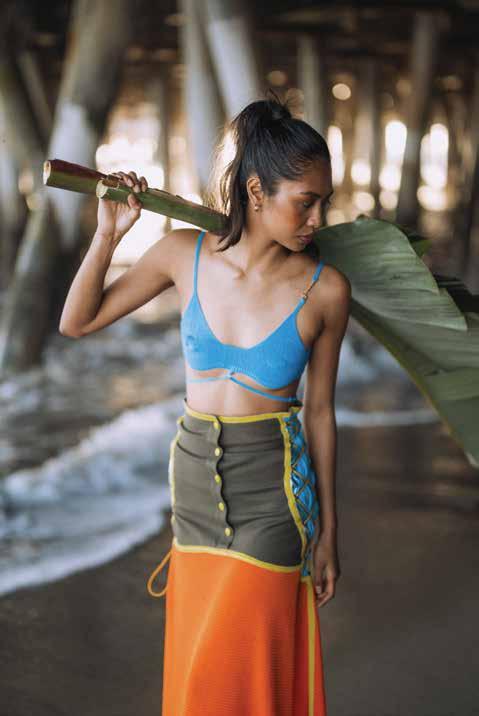 Right: Mesh snap skirt by Issey Miyaki - Price NA; Knit Bralette by Jacquemus - $240
Right: Mesh snap skirt by Issey Miyaki - Price NA; Knit Bralette by Jacquemus - $240
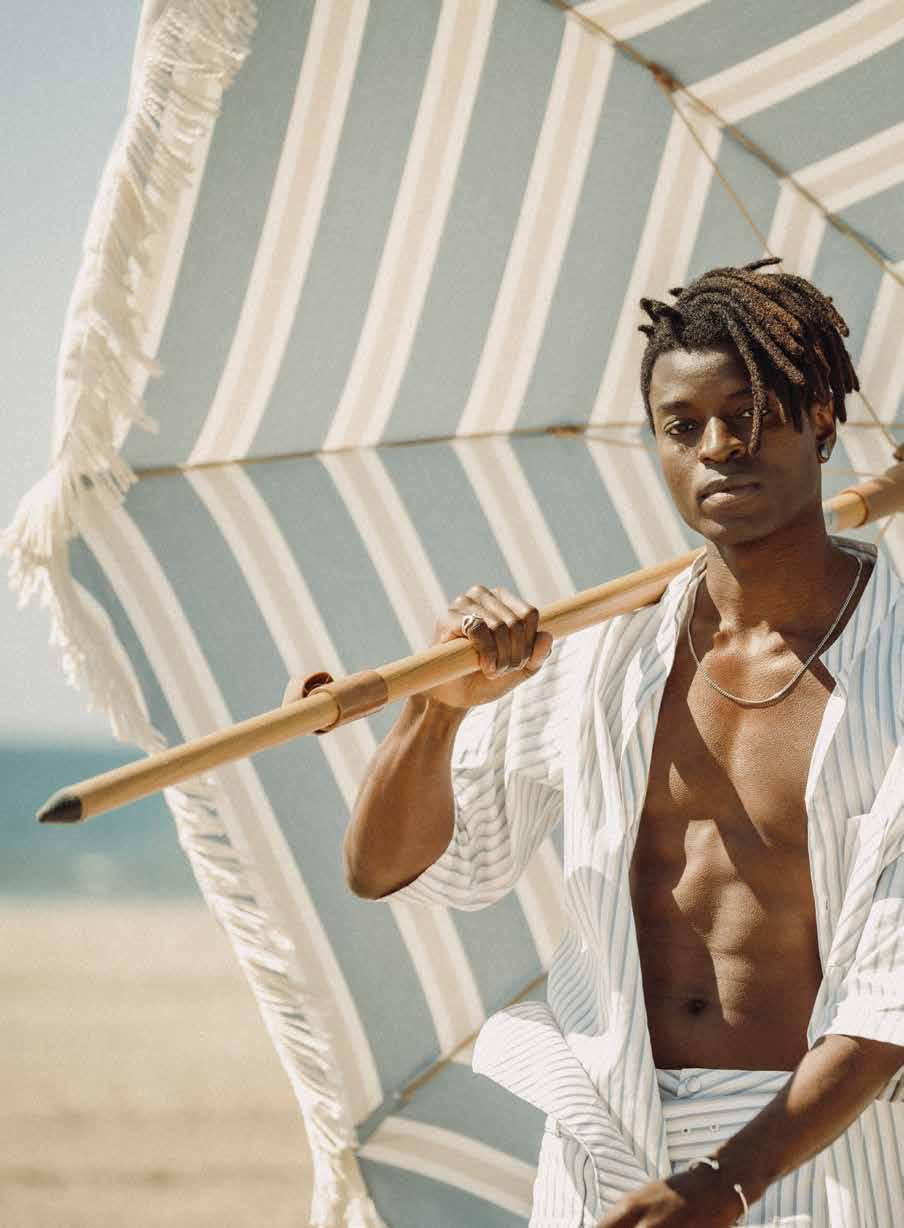
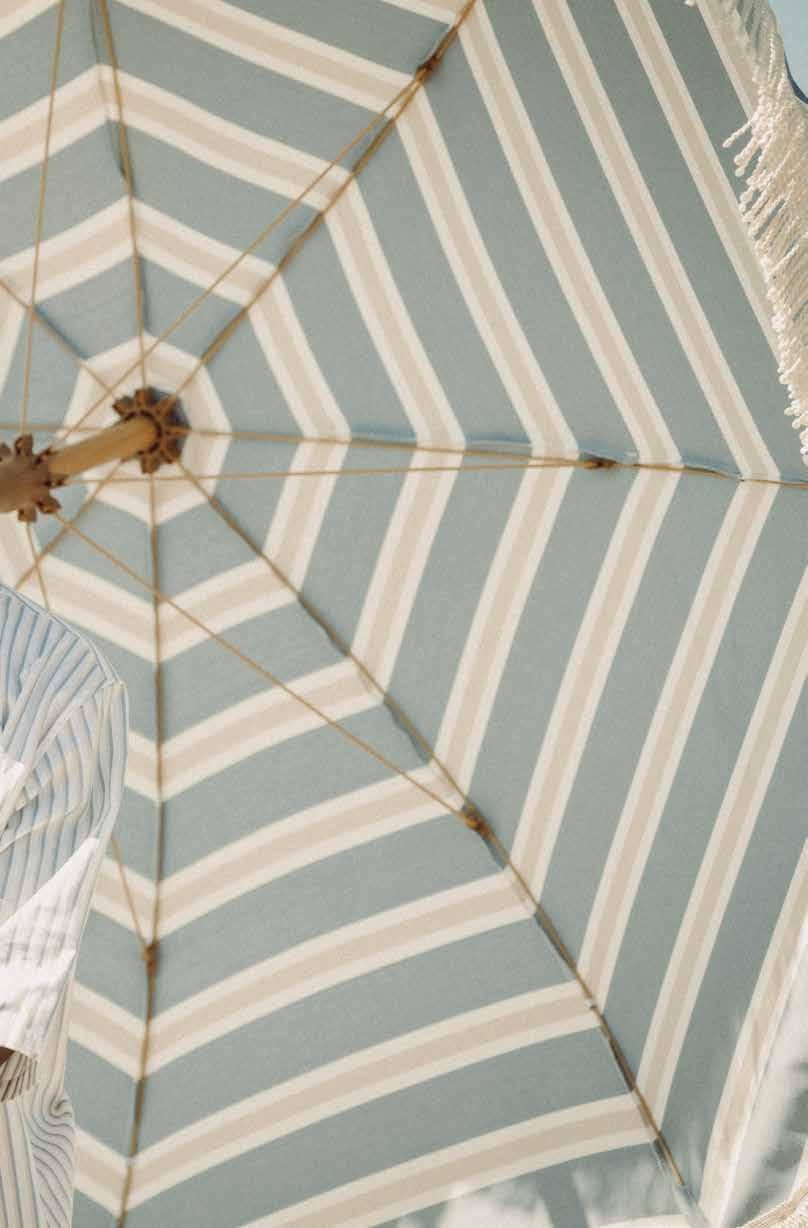
 Left: Acne Studios Simon Fluid Horse Viscose Short - $550
Next page: Prada Re-Nylon Bermuda Shorts - $1200
Left: Acne Studios Simon Fluid Horse Viscose Short - $550
Next page: Prada Re-Nylon Bermuda Shorts - $1200

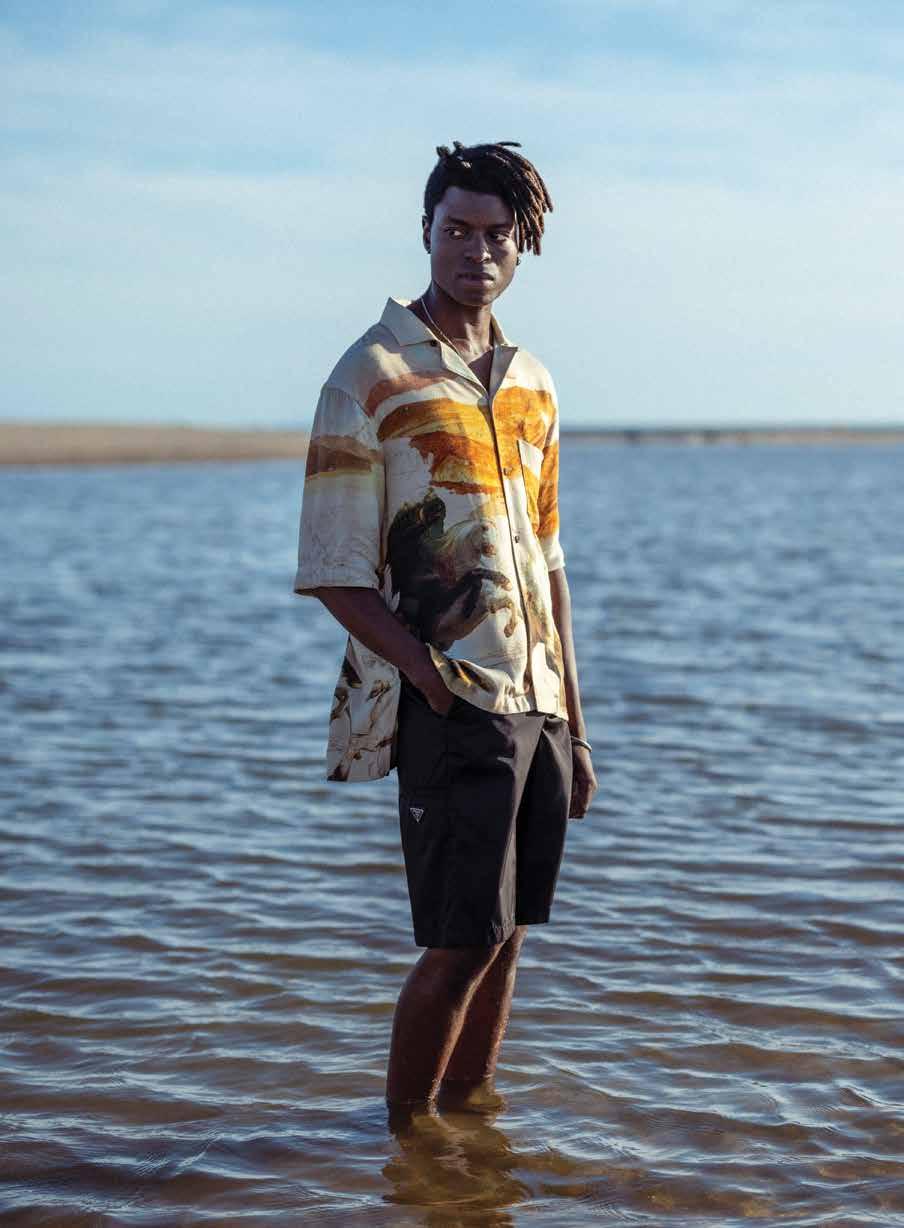
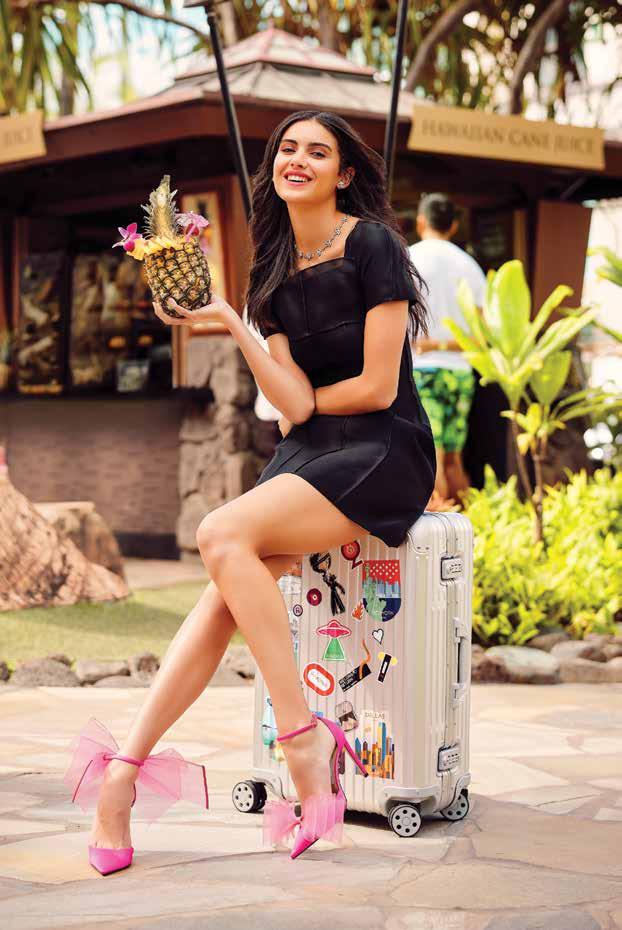
FROM SUN UP TO SUN DOWN, THERE’S MAGIC AROUND EVERY CORNER. Fashion. Dining.
from day to night I Ka Pō Me Ke Ao Fendi | Harry Winston | Hermès | Tiffany & Co. | Jimmy Choo | Stüssy | Rimowa | Saint Laurent Ferragamo | KITH | Tory Burch | Valentino | Tim Ho Wan | Doraku Sushi | Island Vintage Wine Bar Restaurant Suntory | P.F. Chang’s | The Cheesecake Factory | TsuruTonTan Udon | Wolfgang’s Steakhouse Noi Thai | Partial Listing RoyalHawaiianCenter.com • Waikīkī • Open Daily • 808.922.2299
Culture.
Get to know the woman behind the looks in our beach fashion spread.
Two blocks away from Santee Alley, the downtown hub for the city’s most savvy wholesale shoppers and D.I.Y. fashionistas, is where fashion phenom Keyla Marquez operates her styling and wardrobe rental business, LUJO Depot. Inside, she combs through racks of designer clothing in eye-popping shades of hot pink and Orange Julius—neighboring an array of black leather and latex goods, accented with industrial hoops, tassels and other splashy accoutrements. When I ask about her latest project, she gestures towards a mood board littered with Tarot cards and looks that correspond with their meanings. It’s a concept she devised after pulling some cards for herself.
“For me, fashion is all about storytelling,” she says enigmatically, lighting a Palo Santo candle. “What’s your story?”
As a stylist to the stars, Marquez has counted intrepid artists like Frank Ocean, Rosalía and Becky G among her clientele. Now, as fashion director for the L.A. Times’ über-chic lifestyle magazine, IMAGE, Marquez has used the space to flaunt the city’s distinct urban style, through the eyes of the people who keep it
running: communities of color, immigrants, and their dauntless city slicker children.
“I grew up delivering the L.A. Times with my parents when I was a teenager,” Marquez marvels, nearly two years into her tenure at the paper.
Marquez was born in 1985 in El Salvador, where she came from a long line of dressmakers. “I was literally born into fashion,” she says. “My mom had her own clothing line and so did my grandmother. I grew up running around their factories, making dresses for my dolls. My aunt would make me the craziest dresses, and I always looked like a princess.”
Yet by the late 1980s, civil war had swept the Central American country. At the age of 5, Marquez and her family fled to the United States on foot, passing through Guatemala, Belize and Mexico before they settled in Studio City. While her parents worked double shifts, Marquez spent her high school years poring over fashion magazines and orbiting skate parks with her friends. After high school, she landed a job at a local American Apparel, the L.A. brand known
Keyla Marquez: Style for Miles
images by Tim Aukshunas
60
text by Suzy Exposito
Stylist Keyla Marquez in front of Hotel Casa del Mar.
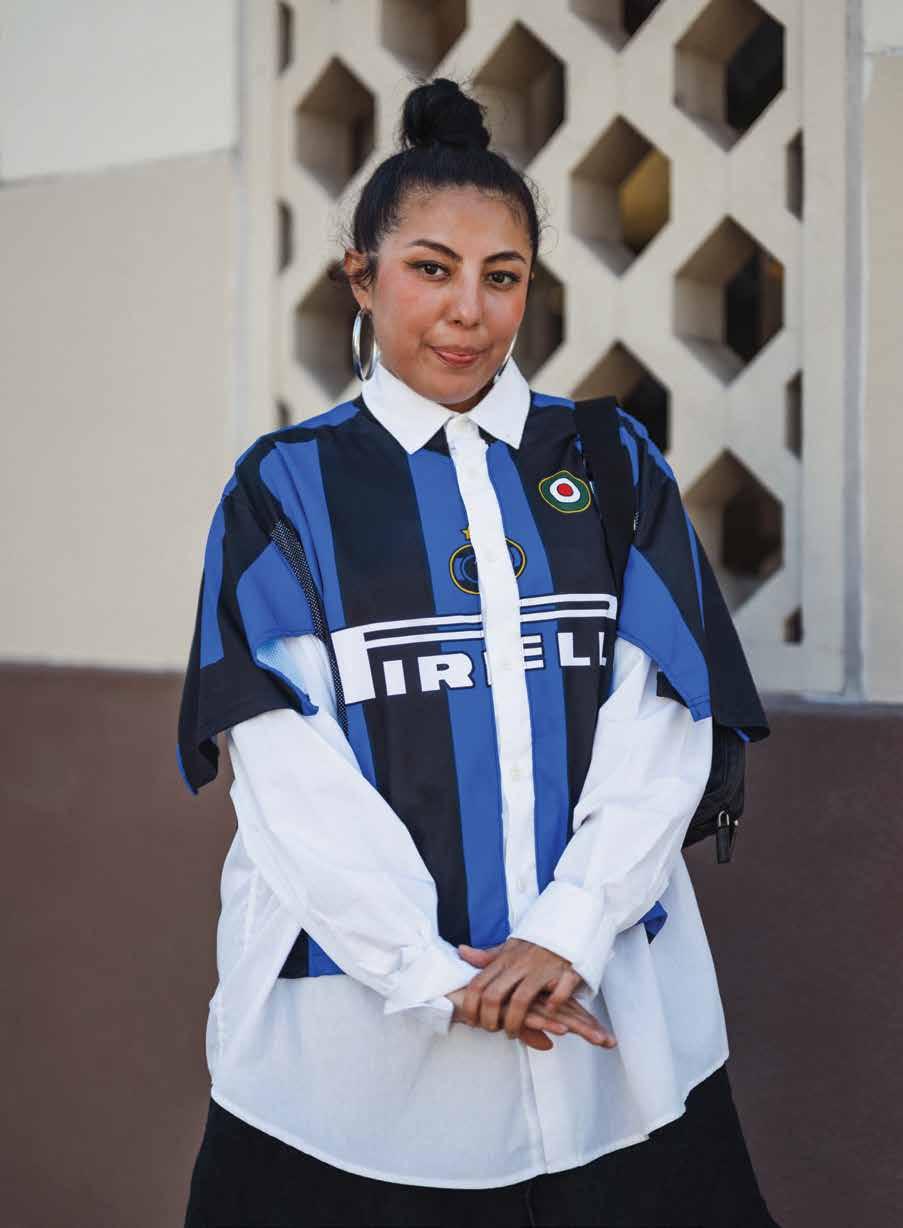
best for its skin-tight, dayglo bodysuits that changed the course of 2000s style.
The label’s upcycling of 1970s and ‘80s aesthetics inspired Marquez to approach her own personal style, long shrouded in black, baggy skater fare, with much more glamour.
“There opened this new world where you’d dress up to be seen at parties, then wake up the next morning and read the blogs to see if your photo was uploaded,” says Marquez. “Fashion bloggers were the new fashion critics of the time. [Blogs like] The Cobrasnake and Last Night’s Party were the runway.”
Moved to make a scene on these digital runways, Marquez convinced her mom to finally teach her how to sew. “I made all my clothes based on this one pattern that my mom gave me, and I made a new outfit every night before going out,” she says. “Like a Cinderella dress, it would fall off me by 2 a.m.”
Her dresses eventually piqued the interest of local boutique sellers, who began selling her limited-run creations; she named her label “Howl” after the epic Allen Ginsberg poem, with a nod to the spirit of the Californian beatniks of yore. Mischa Barton, star of the CW series The O.C., was
photographed rocking a few of Marquez’s colorful designs through West Hollywood.
Marquez eventually took classes in fashion merchandising to better hone her business acumen, and worked with fashion photographer friends to build a following on Instagram. It was while working a day job at an architecture firm that Marquez received her first big break in 2017: she was asked to style Frank Ocean on tour that year, while promoting his seminal avant-R&B album, Blond. “Going on tour and seeing Frank wear stuff I curated...I was like, ‘This is it. This is what I want to do,’” she says.
Deflated by the increasing dominance of fast fashion, and the paint-by-numbers looks she sees prescribed on TikTok, Marquez says she’s reverted back to hitting old costume design books for inspiration and even finds herself mining the alt fashions from her teen years at the skate park for material.
“I’ve always been inspired by my city and the kids here,” she says. “I love going to flea markets to see what people are wearing. I love going to shows, art openings. In L.A. you’ll see someone wearing a $600 sweatshirt with a pair of old Dickies and Gucci loafers—I call it ‘high low’ fashion. We can make it luxe, but we also make it relatable.”
62
Marquez readies a Waves model for her closeup.

Wherein we explore why the seaside community is so committed to wellness and wellbeing.
From its storied history of sport and fitness firsts to an enduring attitude of wellness, Santa Monica’s title as a healthconscious coastal haven is undisputed.
While 300-sunny days a year, epic beaches, and cleansing ocean air is motivation enough to live a healthy lifestyle, Santa Monica stands apart from other beach towns dotting the Southern California coast. There’s just something about the city’s 8.3 square miles that oozes vitality. Whether Santa Monica’s unshakeable health-savvy stamp is part of a well-crafted plan to design an enclave of wellness, or simply a side effect of its fit-focused heritage, all varieties of activity and mindfulness are welcome here.
Santa Monica resident and Waves contributor Anne Wallentine suggests her fair city emanates an openness to adventure that spills over from the metropolis to the east: “L.A. is a place that attracts a lot of people who are interested in exploring new frontiers, whether it’s health or arts or whatever they’re into.”
As a curator for the Santa Monica History Museum, she’s studied the city’s evolution over the last century. “Santa Monica used to be more of a sleepy beach town on the fringes of L.A.,” she says. “When the freeway was built in the 1960s, that was a turning point for the city—both for connecting it to broader Los Angeles and attracting more of an upscale tourist crowd.”
A true mecca of movement, Santa Monica offers easy access to the great outdoors, high walkability, and close proximity to ocean and mountain terrain. The 3.5-mile Santa Monica State Beach is a perpetual playground for everyone from surfers, kayakers, kitesurfers, runners, and volleyballers, to stillness-seekers practicing meditation and sound bath sessions on the sand.
Scenic overlooks and palm-studded paths turn public spaces like Palisades Park into enchanting exercise venues. Resources like the iconic Santa Monica Stairs—170 steps descending an overall vertical change of about 110 feet into Santa Monica Canyon—challenge everyday athletes and weekend warriors. The city’s robust bicycle infrastructure caters to peddlers with the Metro Bike Share program, the 22-mile Marvin Braude Bike Trail tracing the shoreline, and a 20-year Bike Action Plan aiming for 35% bicycle mode share by 2030.
While fitness is always on-trend in California, Santa Monica boasts a bevy of physiquebuilding options: Brazilian jiu-jitsu and boxing academies; Pilates, Barre, HIIT, and cycling studios; and all-encompassing gyms and health clubs, to name a few. There’s also an eclectic assortment of day spas that perform holistic relaxation and recovery therapies, from the more traditional massages, facials, and body scrubs, to biohacking methods such as sensory deprivation tanks, infrared saunas, and cryotherapy.
64
Santa Monica Sustenance text by Lindsey Kesel
Yoga on Santa Monica State Beach. Image by Christopher Brown/ Shutterstock.com
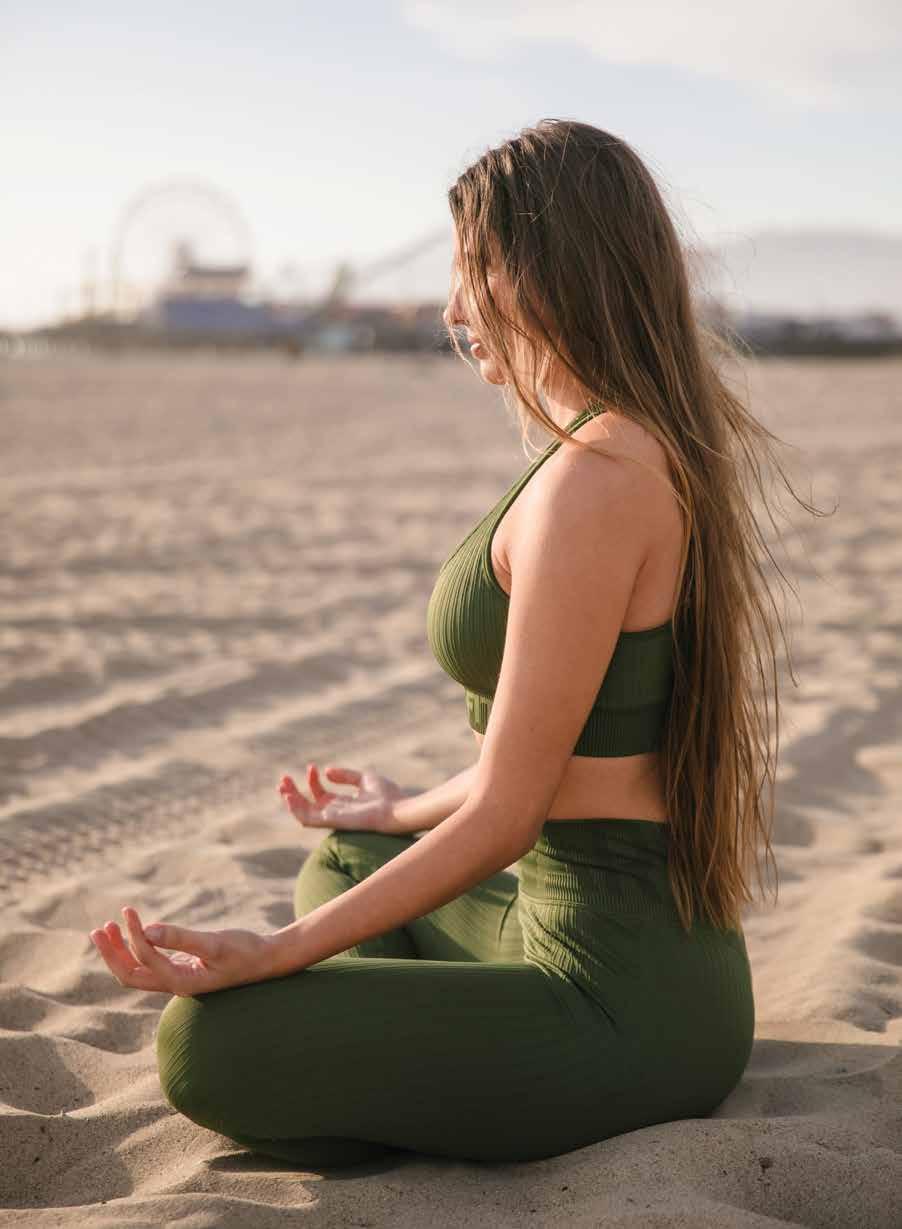
In 2018, after noticing most of his clients were Santa Monica residents, personal trainer Julian Hess went from doing home visits to hosting workouts at The Study L.A., a “fitness sanctuary with 2,500 square feet of ultra clean, human-powered training space located in the heart of Santa Monica.”
With a wealth of ways to shape up, Hess helps clients find the right fit, then apply consistency and effort. “Do that mud bath or meditation, but understand that’s not going to help you do a push-up. Choose the thing you really love doing and get after it,” he adds.
Santa Monica’s affinity for wellness also extends to conscious cuisine, from organic farmer’s markets and farm-totable restaurants, to scores of healthy fast-casual eateries. One popular stop in downtown, The Hive Superfood Eats & Organic Café, is known for its “sneaky healthy” juice blends, kombucha tea, immunity shots, and build-your-own bowls.
After Richard Peters and Constantine Savvides met on a 10-day Vipassana meditation retreat, they opened The Hive with the intention to build a community around true nourishment. With a mantra of “bee yourself,” The Hive caters to the spirit of individualism the city is known for with a flexible, modification-friendly menu.
“Santa Monica is probably one of the healthiest cities in the country as far as the general mindset of people,” says Peters. “People tend to have a holistic approach to eating better and living healthier, versus having to go to the doctor when you have a problem.”
Santa Monica’s high health IQ owes a sizeable debt of gratitude to earlier decades that championed innovations in sports and fitness. Even before the “Z-boys” of Zephyr Skate Team put the city’s Ocean Park neighborhood on the map with their surf-styled skateboarding, Santa Monica was launching the new water sport of paddleboarding and kicking off a fitness phenomenon on Muscle Beach.
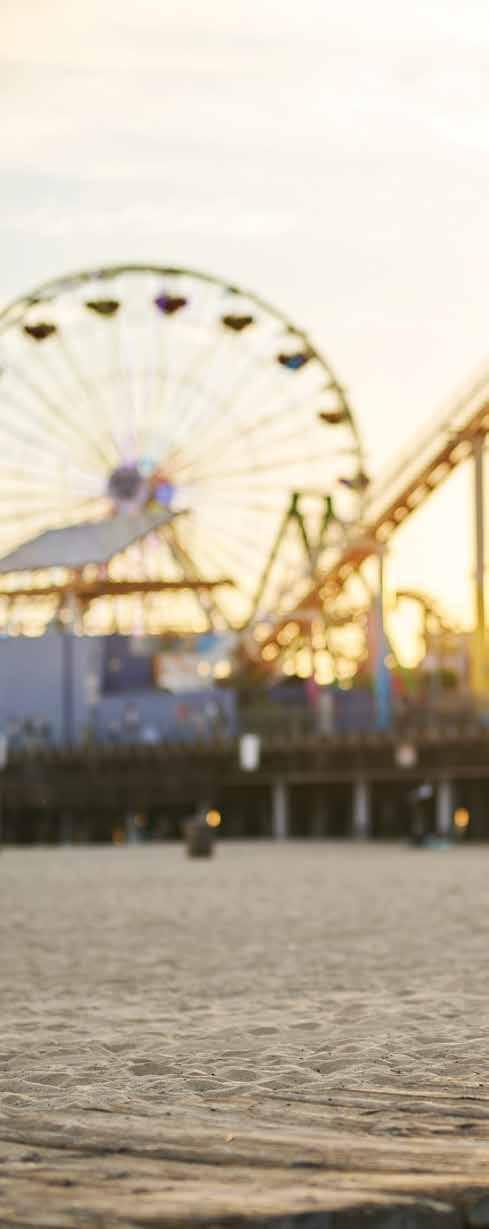
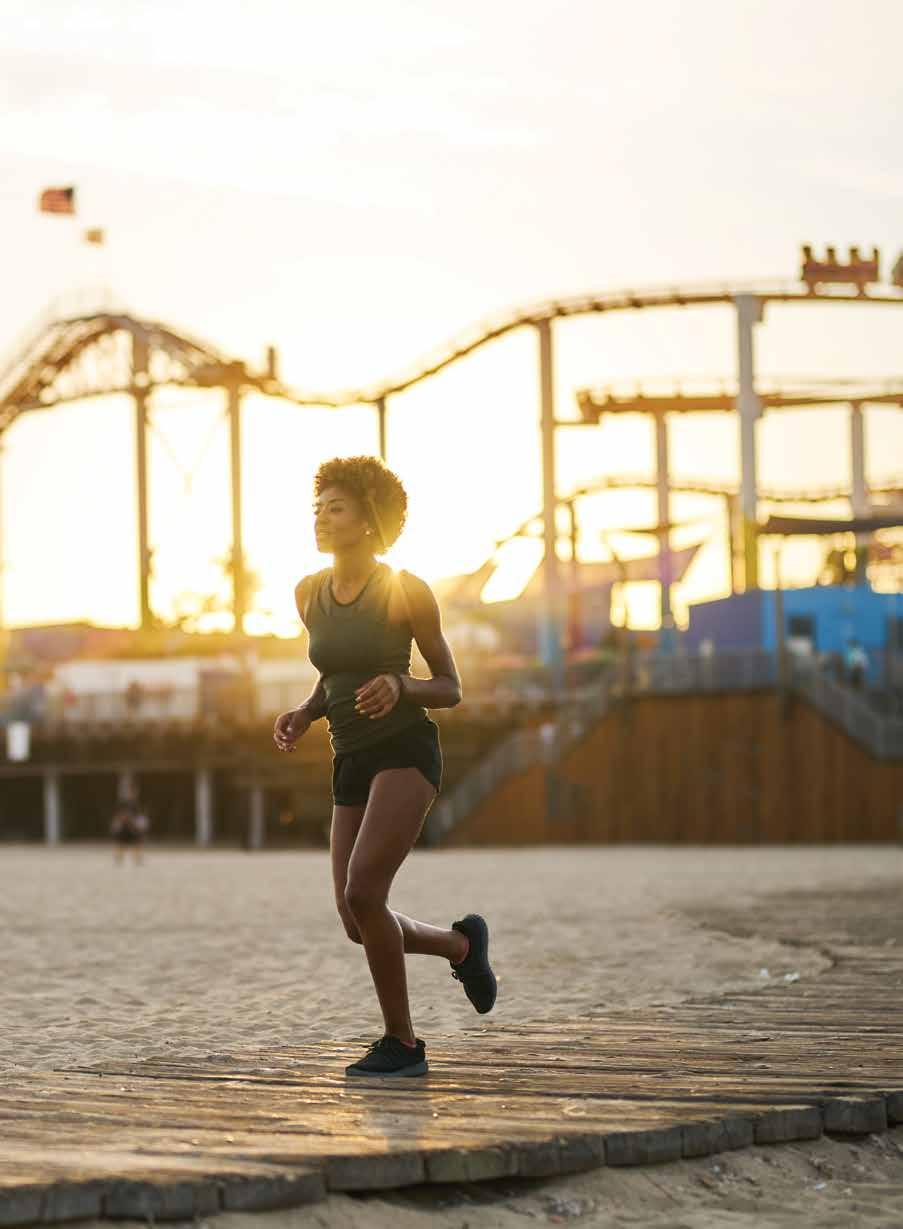
Though stand-up paddleboarding (SUP) took root with legendary Waikīkī watermen in the 1950s, a simplified version is said to have originated in Santa Monica harbor in 1932 with surfer Tom Blake. Blake modified the heavy 14-foot-plus wooden surfboards the Hawaiians were riding, built a lighter, hollow board strictly for prone paddling with the arms, and shared them with the local lifeguards. As paddleboarding took off, two spinoff sports also originated in the harbor—paddleboard water polo and paddleboard water ballet.
Jim Harris, executive director for the Santa Monica Pier and author of the 2009 book The Santa Monica Pier: A Century on the Last Great Pleasure Pier shares the origin story of the country’s first public paddleboard club:
In 1940, Ed Hawkins entered his 9-year-old daughter, Dorothy “Dottie” Lee Hawkins, in a paddleboard race against adult athletes at Ballona Creek. When Dottie took third place, Ed knew he needed to nurture her talent, but there was the matter of cost. Balking at the high fees the private clubs were charging, Hawkins founded Hui Maiokioki (later renamed Manoa Paddleboard Club) on the west end of the Pier, with no entry fees and 25-cent monthly dues. Throughout her career, Dottie never took less than first place, and became the personal paddleboarding trainer for Olympic gold medalist swimmer and ‘Tarzan” actor Johnny Weissmuller.
In the 1930s, the exercise extravaganza Muscle Beach was branding Santa Monica as the birthplace of the fitness movement. Just south of the Pier, a motley crew of amateur athletes drew crowds with their dynamic displays of acrobatics, gymnastics, wrestling, human pyramids, and stunt performances. As word spread, famous actors, celebrities, and bodybuilders came through. Though Muscle Beach eventually relocated to Venice Beach, the Original Muscle Beach location continues to attract “families, fitness freaks, and tourists” with a setup of parallel bars, ropes and swings, and aerial silks.
Today, the Santa Monica Pier remains a lively launch pad for the city’s “something for everyone” appeal, playing host to myriad fit-focused events like the Arnold Strongman USA Championship, Wanderlust Festival, and Wellness and Waves’ free yoga by the sea. The granddaddy of them all, the annual Pier 360 Ocean Sports and Beach Festival in June, celebrates the city’s legacy of innovation and inclusivity with epic “paddle battles” and surf, skate, swim, and other competitions that are open to anyone up for a challenge. For visitors who prefer to just hang out, Santa Monica Trapeze School gives lessons right on the Pier to test one’s inner acrobat.
“Santa Monica just has a coolness about it,” says Hess, the trainer. “Being healthy is part of the culture here. Everyone wants to look good like a Hollywood movie star, and they’re out here getting fit.”
Pg 66-67 At all hours of the day, you can find people running and biking by the Santa Monica Pier. Image by Joshua Resnick/ Shutterstock.com
68
Right: Santa Monica’s high health IQ and “holistic approach to eating better” can be seen all over. Image by Jonathan Borba


image
Tim Aukshunas
by
PEOPLE
. ”
“
Wine can tell a lot of stories
Discover the best Westside wine shops and tastings.
While there are exceptional wine bars across Los Angeles, Santa Monica’s breezy terroir seems to foster spaces that are both luxe and relaxed, where curious wine-drinkers can find anything from the latest local, biodynamic wines to classic international appellations.
For timeless wines in a stylish spot, Esters, Rustic Canyon Group’s Art Deco gem of a wine bar, hosts themed tastings on Sunday afternoons (12-9pm). Their Monday cellar nights (4-10pm), when they open rare and high-end bottles, shouldn’t be missed.
Far from champagne problems, Esters has declared 2024 the year of “Champagne Resolutions.” Co-owner Kathryn Coker says champagne shouldn’t just be for special occasions, so Esters is offering more champagnes by the glass as well as a wide variety of bottles on their shelves.
The newest shop on the block, Divine Vintage, has brought a well-curated charm and a popping patio scene to Montana Avenue with its unique combination of wine and vintage clothing. Their popular weekend tastings (Saturdays and
Sundays, 2-6pm) and expert selection of bottles have drawn local celebrities through the door —although the team is far too discreet to share names.
Community “is what drives it all,” says David Kianmahd, Divine’s operations director. Partners and co-owners Nick Dumergue and Jen Rush combined their love of wine and vintage treasures to “create a gathering spot where you can come in and enjoy the ‘take-me-away’ adventure of wine and cool things,” Kianmahd says.
New Zealand-born Dumergue is a globetrotting sommelier who has worked “all over the world and [in] every part of the wine business,” as he explains. His extensive personal experience informs the bottles that line the shelves: “These are all my favorites,” he says. Dumergue looks for “classic wines of the world” that are “classic for a reason,” while keeping an eye to modern tastes for natural and orange wines. Around 90% of the wines are international, to encourage customers to explore wine regions beyond California. He has found that “the neighborhood’s really curious and they want to try new things.”
A Guide to Help Un-Wine(d) by the Beach
72
images by Tim Aukshunas text by Anne Wallentine
Los Angeles-based wine influencer Andrea Jaramillo.
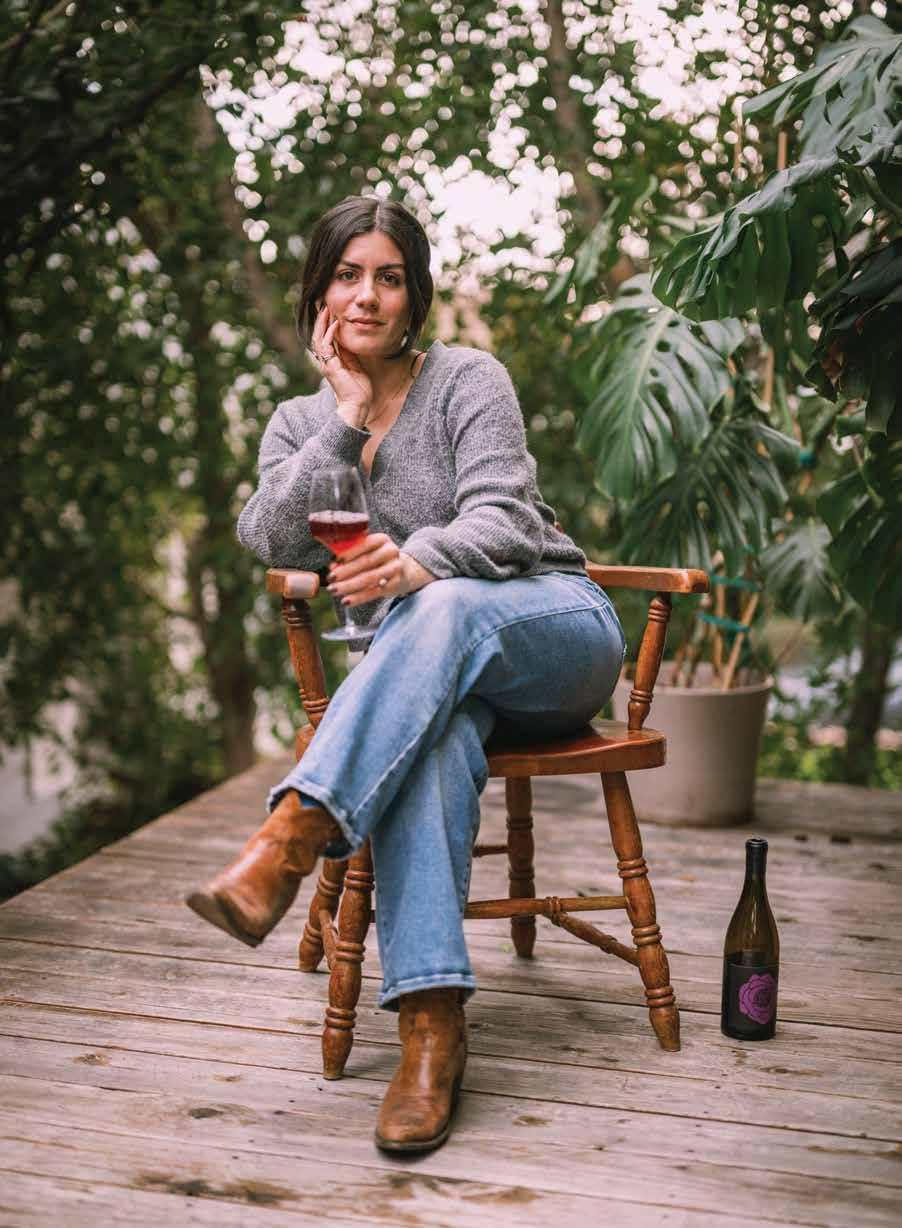
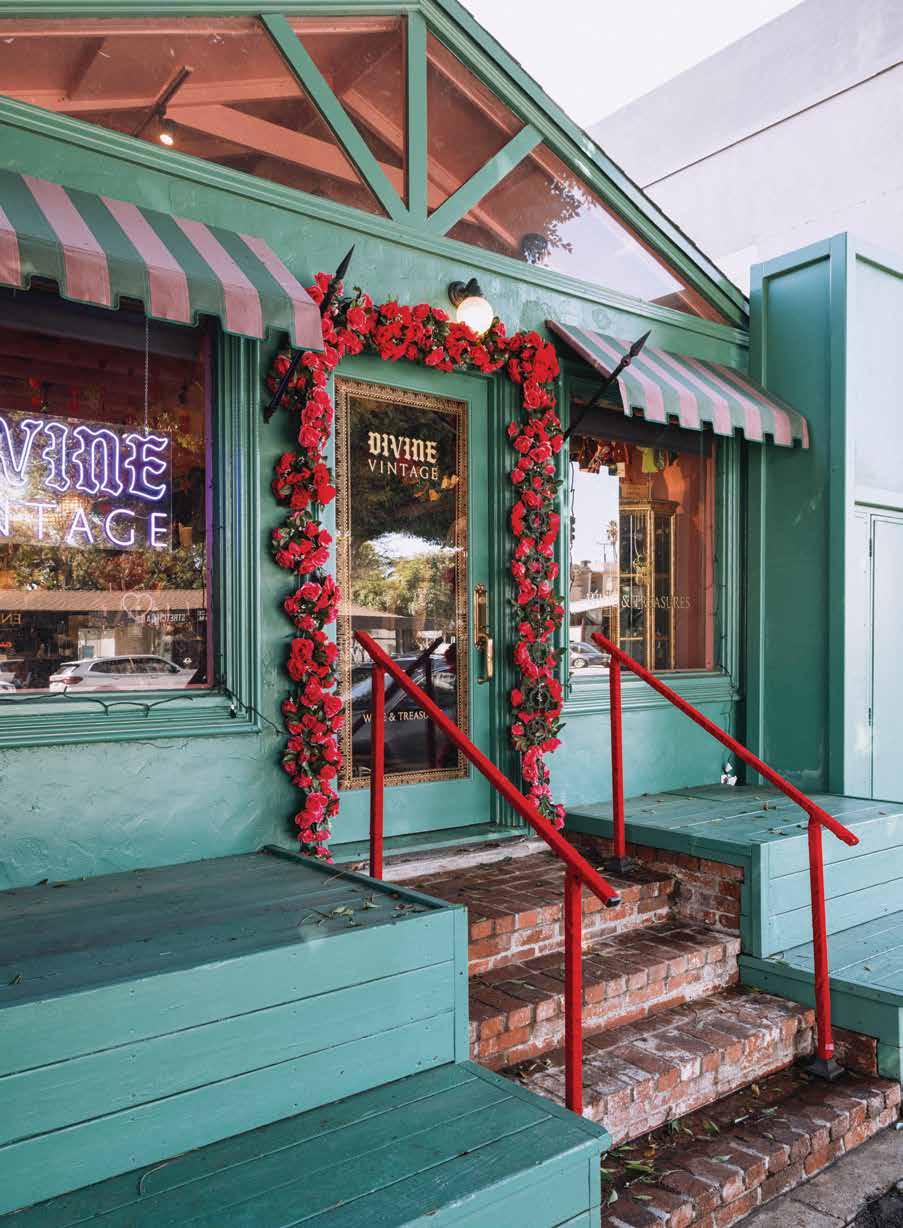
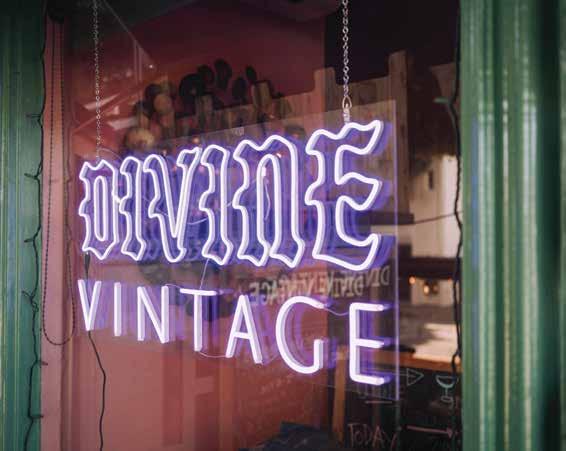 The newest shop on the block, Divine Vintage, has brought a well-curated charm and popping patio scene to Montana Avenue with its unique combination of wine and vintage clothing.
The newest shop on the block, Divine Vintage, has brought a well-curated charm and popping patio scene to Montana Avenue with its unique combination of wine and vintage clothing.
It’s the elegant, “Cheers version of a wine shop,” Kianmahd says: small and cozy enough to be neighborly but refined and curated enough to find a bottle for any occasion—and perhaps even a champagne saber, should you need one.
If Divine is the smart, maximalist neighborhood spot where everyone knows your name, Offhand Wine Bar is the cool, minimalist cousin who can show you around town. Offhand was opened in 2022 by Westside Winos, a group of friends, wine lovers, and DJs: Justin Leathers, Teron Stevenson and Khalil Kinsey. Their taste for “pairing wine and music,” as Leathers puts it, has made their otherwise unassuming corner on Santa Monica Boulevard a buzzy weekend hotspot, mentioned in actor Issa Rae’s list of L.A. favorites.
Offhand’s staff-selected tasting flights rotate weekly, and they partner with local food pop-ups on the weekends. Sundays alternate between elevated French seafood bistro Mignonette and the Serrano Experience’s Spanish Basque cuisine.
Their wines are selected entirely from the West Coast, from Valle de Guadalupe
to Washington’s Colombia Valley, with an emphasis on “from-our-backyard, California natural wines,” Leathers explains. They’ve been excited to introduce skeptics to natural wines, and see people of “all ages, all generations” enjoy their space and their efforts to bring “a little more culture to Santa Monica.”
“It’s really cool being able to branch the culture and wine and make that intersect,” says wine influencer Andrea Jaramillo. Most people might default to red, white, or rosé—but for Jaramillo, it all began with an orange wine. A down-to-earth connoisseur, Jaramillo got her start as “a regular person who likes wine” and “wanted to share what wines I was drinking with my friends.” A few months after she started her TikTok channel Mas Vino Please in 2020, a post about orange wine helped it take off. Today, she has nearly 40,000 followers, a successful newsletter and podcast—all of which aim to make wine fun and accessible.
For the events and tastings that Jaramillo hosts around the city, “I’m always trying to find wines that I don’t think people will naturally gravitate to on their own,” she says. “I always try to showcase wines that people
“Wine can tell a lot of stories,” says Jaramillo. It’s about the artistry and regionality of wine as well as “the communities that surround it” and the people who consume it together.
76
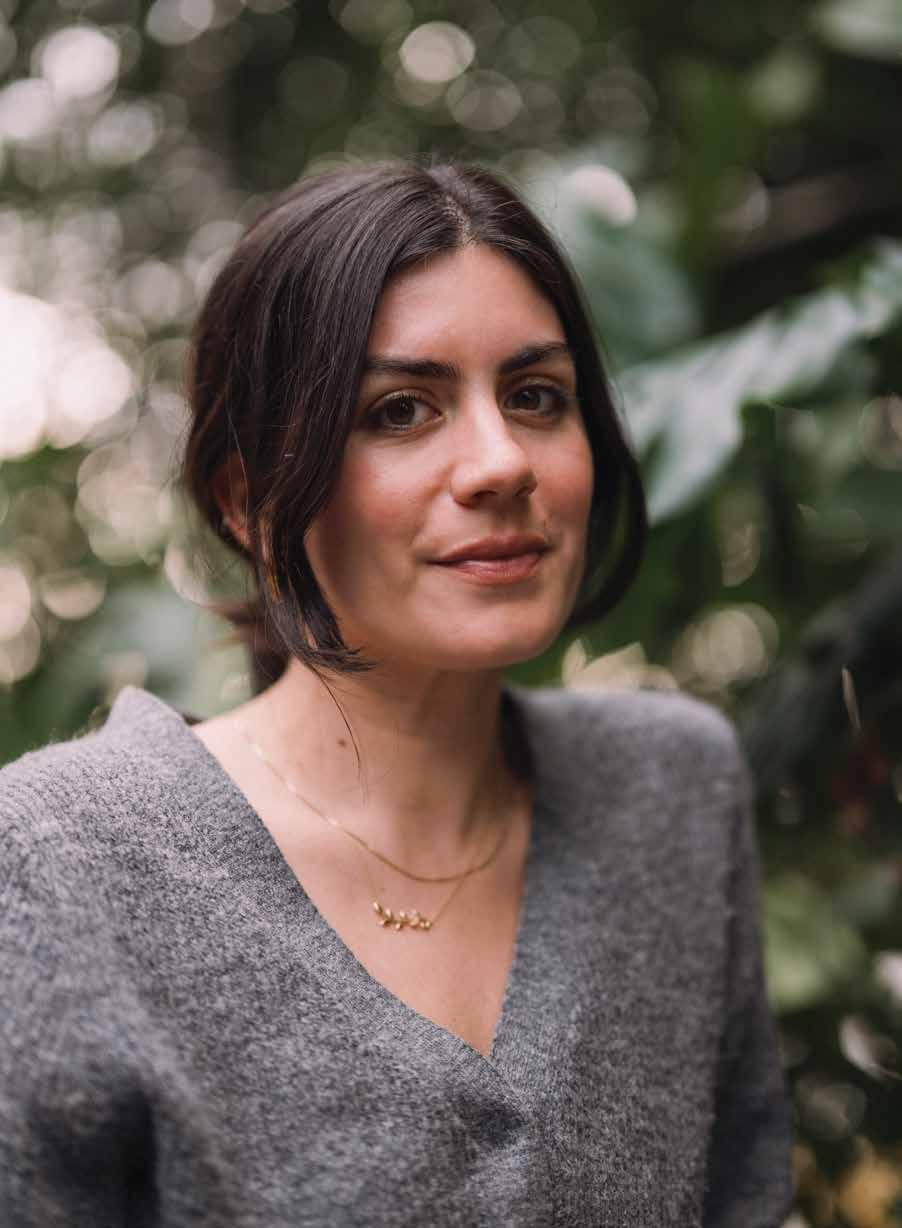

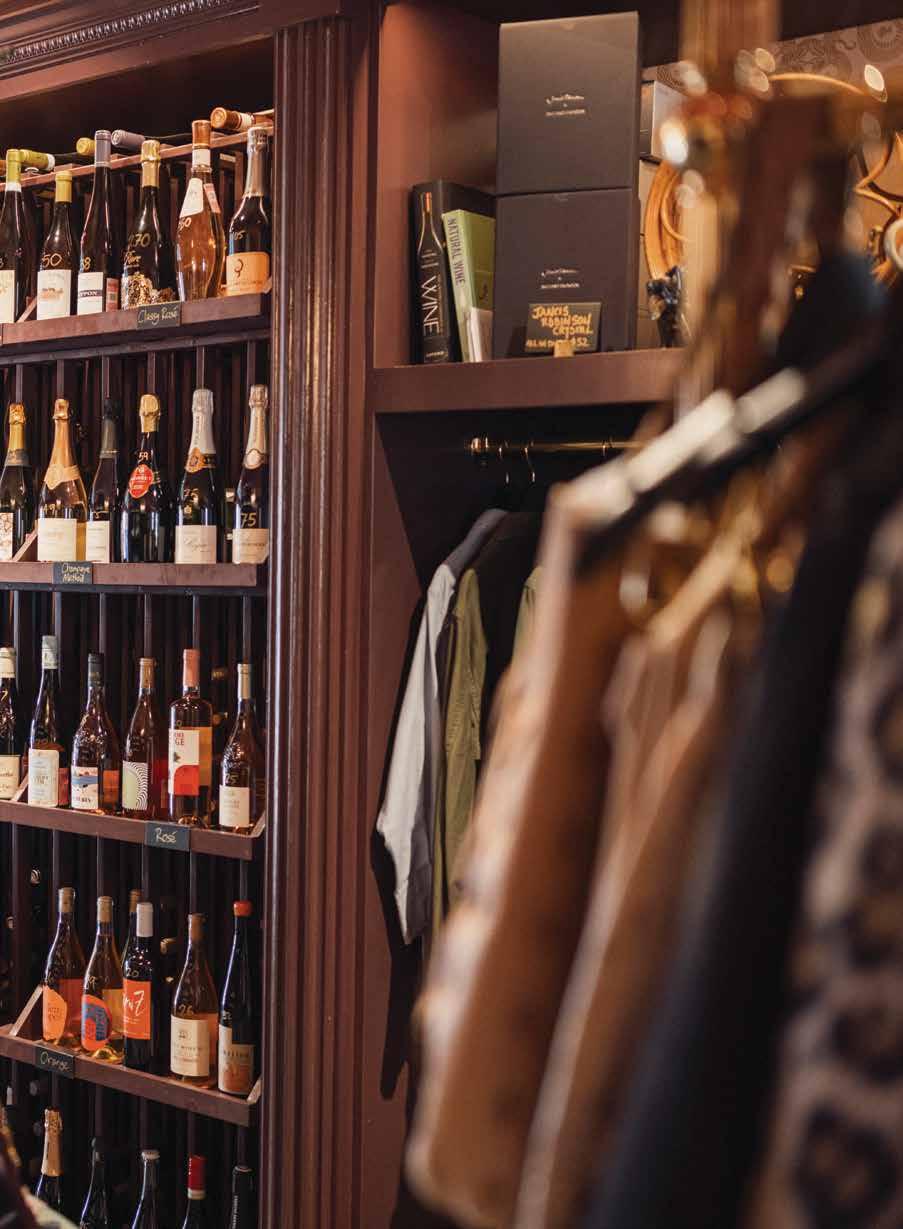
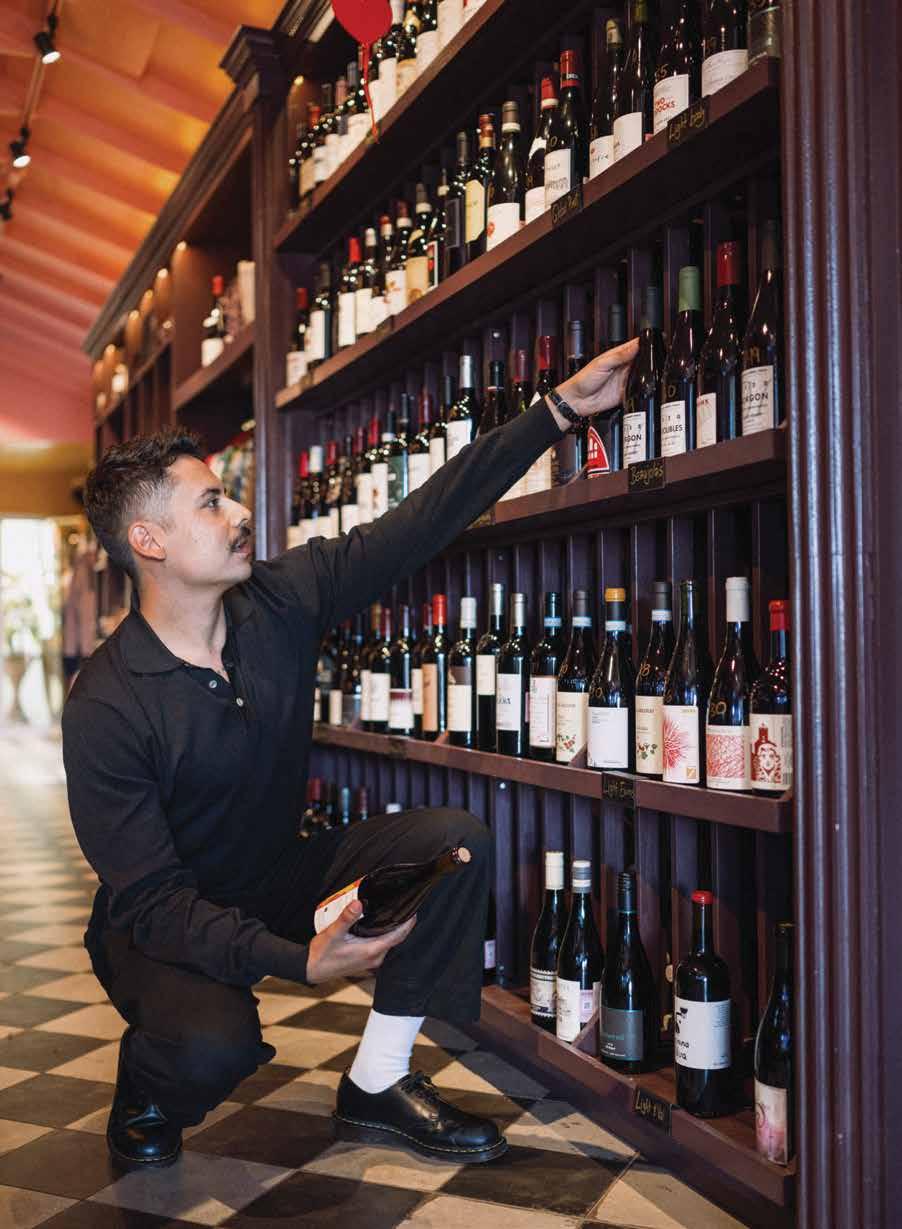
 Above: Offhand Wine Bar opened in 2022 by Westside Winos, a group of friends, wine lovers and DJs. Left: Sommelier Nick Dumergue stocks the shelves of Divine Vintage, the spot he co-founded. Page 78 - 79, Divine Vintage.
Above: Offhand Wine Bar opened in 2022 by Westside Winos, a group of friends, wine lovers and DJs. Left: Sommelier Nick Dumergue stocks the shelves of Divine Vintage, the spot he co-founded. Page 78 - 79, Divine Vintage.
might not go for, and kind of open them up to a different avenue of exploration in wine.”
Each oenophile shares that enthusiasm for exploring new wines. For recommendations, Leathers points to Berkeley-based Broc Cellars’ Got Grapes on the bar’s subtle retail shelves—which double as décor—as one of the bottles that got him into natural wine. Dumergue, meanwhile, is excited about wines coming from the north and south of Italy: Piedmont and Sicily’s Mount Etna. He’s also keen on encouraging the recent interest in Portuguese and South African wines.
Jaramillo finds herself drawn to sophisticated “natural wines that are very clean and dialed in and aren’t overly funky,” and is excited by the contemporary wines coming from the San Luis Obispo Coast like Scar of the Sea and Say When. Jaramillo has also collaborated with friends and winemakers Wonderwerk to produce a fruity, floral red wine, Como la Flor, and the sparkling, rose-infused Chismosa. “I wanted to create a wine that felt like it represented
the people I hope will drink it,” she says, so the labels and flavors “speak to Latin culture and the communities I grew up with.”
What do these tastemakers think the future holds for Westside wine? Dumergue has noticed local consumers trending towards lighter, chillable reds, which have softer tannins. Jaramillo notes that, in the US, there is currently “a lot more attention to hybrid grapes,” and in California, more exploration beyond the region’s traditional Chardonnay and Cabernet Sauvignon. She’s intrigued by experiments with California Albariño and Riesling, the latter by vineyards like Cole Ranch.
“Wine can tell a lot of stories,” Jaramillo says. It’s about the artistry and regionality of wine as well as “the communities that surround it; the farmworkers… that are picking the grapes,” and the people who consume it together.
What better way to bring all those stories together than raising a glass?
OTHER WESTSIDE PICKS
If you venture further afield from Santa Monica: Vin on Rose and Venice Fine Wines in Venice and Stanley’s Wet Goods and Bar & Garden in Culver City all offer ace selections and atmosphere.
82
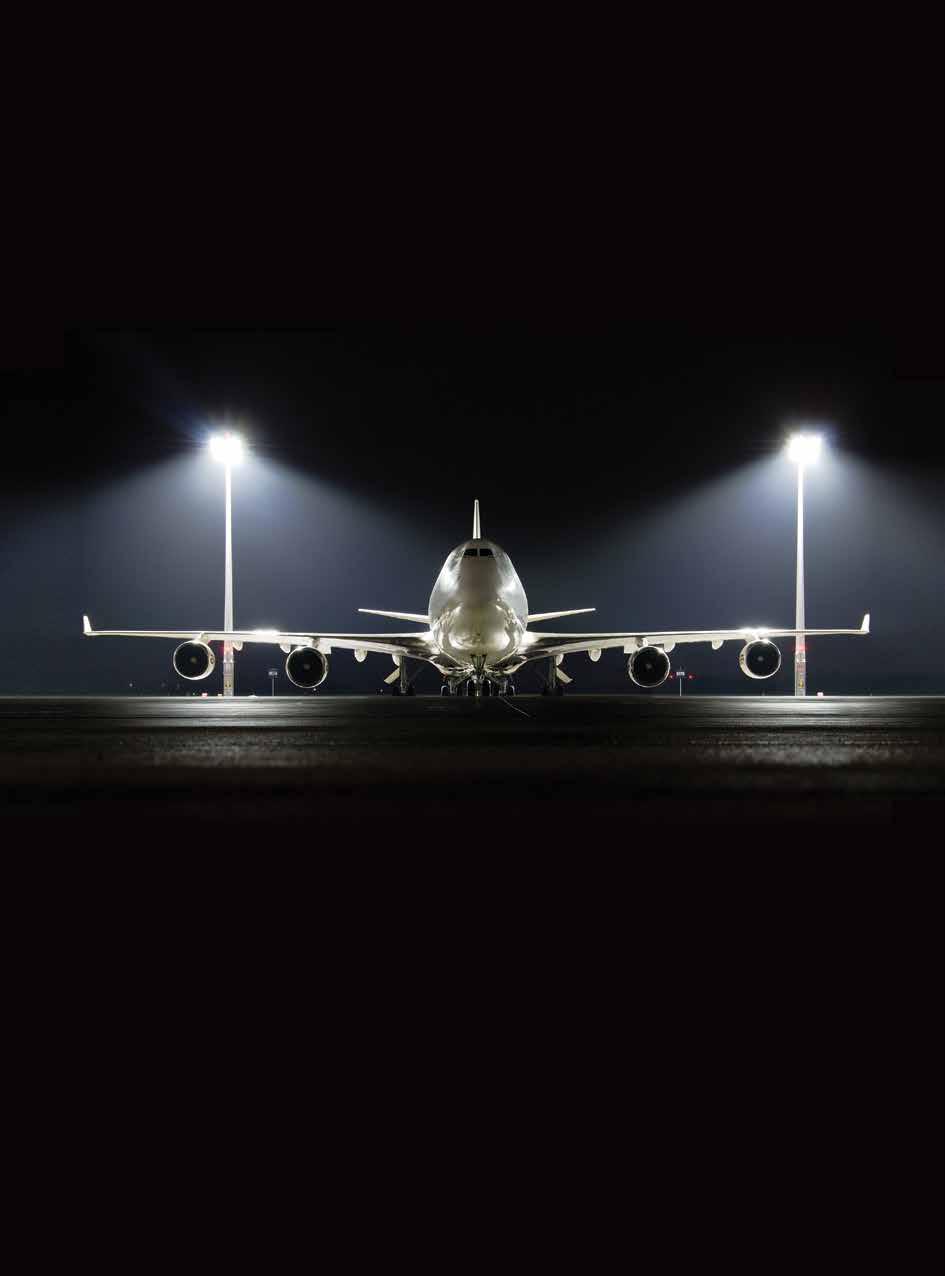
Boeing 747-400 Nose Loader service and Ad Hoc charters on demand. Connecting LAX and HNL daily with daily connections to Neighbor Islands and weekly service to Pago Pago and Guam.
For more information, a free quote or to book online visit pacificaircargo.com or call 213.568.1977 AIR FREIGHT SPECIALISTS
ACROSS THE
CHARTERS
PACIFIC
A local Santa Monica bookshop makes space for celebrity and community.
It’s a rarefied circle that can claim actress and author Dame Joan Collins attended their first birthday party. But Collins was the guest of honor at the one-year celebration of Zibby’s Bookshop, the brick-and-mortar offshoot of Zibby Owens’ book-media empire (Zibby Media) on Santa Monica’s Montana Avenue.
Wry and soignée at 90 years old, Collins arrived for celebrations that included a book signing for her latest autobiography, Behind The Shoulder Pads, and a recording for Owens’ podcast, Moms Don’t Have Time to Read. “I think all bookstores are important, and I’m shattered and horrified by the fact that so many have shuttered,” the actress says, just after signing her new book for fans. “I just hope that some stores will get back. And this is a lovely store, [where] people can sit back and relax.”
“Owning a bookstore is something I had always dreamed about,” Owens says, but the reality of running one has been “beyond my wildest dreams.” Since its 2023 opening, she adds, “the Santa Monica community has completely embraced having this bookstore here.”
Los Angeles has always been a town of writers, but its bookshops have sometimes gone overlooked in a screen-focused city. Classic shops like Book Soup, Small World Books,
and Skylight have remained popular for decades, but many others closed their doors as online retail took over. After downtown Santa Monica’s Bookmonster shuttered in 2022, only the treasure-hunting secondhand shop Angel City Books and Records remained on Main Street. Now, new, specialist shops like Zibby’s have been opening and thriving across the country, driven by community demand. In Santa Monica, in addition to Zibby’s you’ll find Waverly Books and Thunderbolt Spiritual Books.
Owens, who divides her time between New York and Los Angeles, sensed an opportunity after Amazon’s Pacific Palisades bookstore closed in 2022. She started with a pop-up concept, but quickly wanted to develop the space further. “Selling books is only a tiny piece of the puzzle,” Owens says. A bookshop, she says, is also “a community meeting spot. It’s an event center. It’s a place for people to come together and feel a part of something, feel connected, feel inspired, feel moved, [and] know that they have hours of entertainment of their choice at their fingertips.”
The store’s shelves are categorized by identities, emotions, ages, and interests, based on the personal and thematic recommendation style favored by Owens and her co-founders, Sherri Puzey and Diana
Beach Reads images by
text by Anne
84
Tim Aukshunas
Wallentine
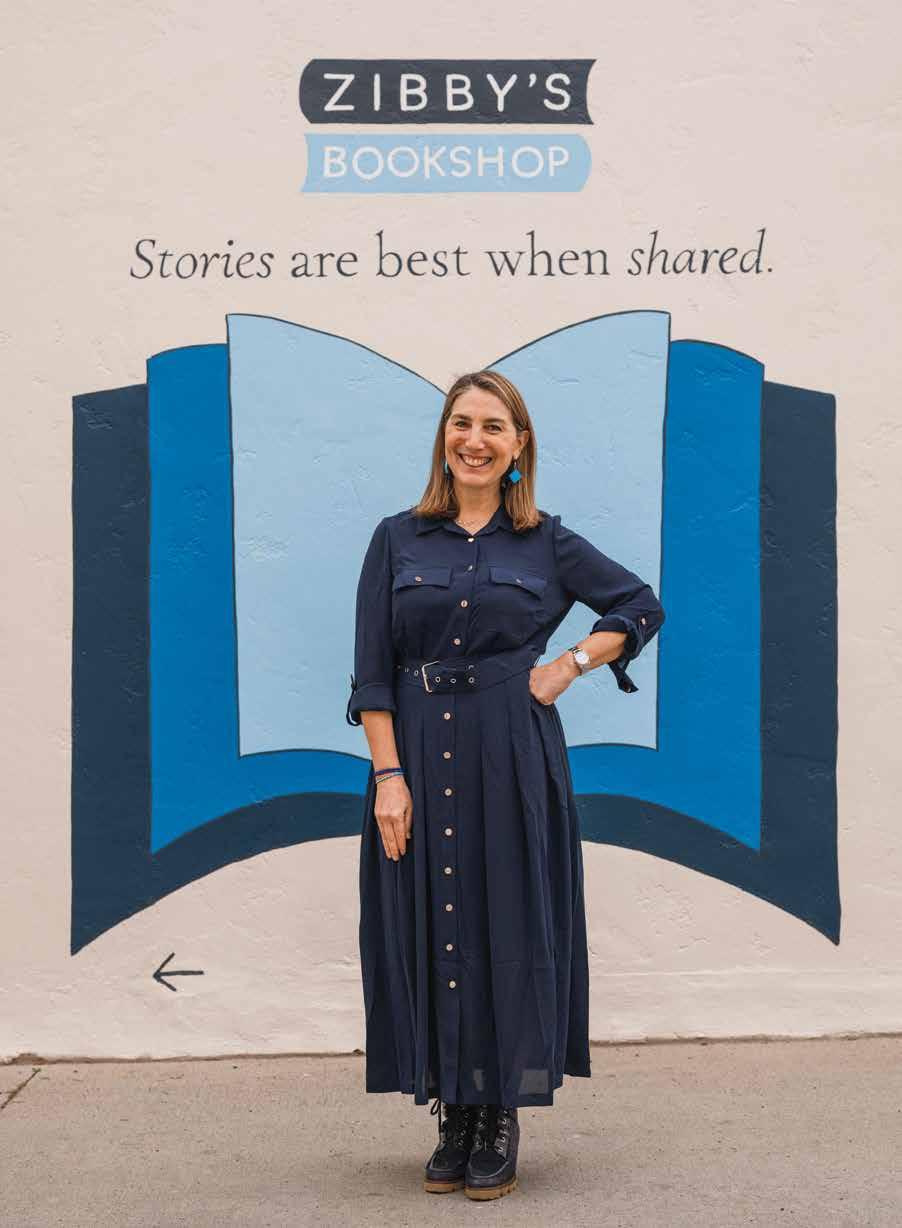

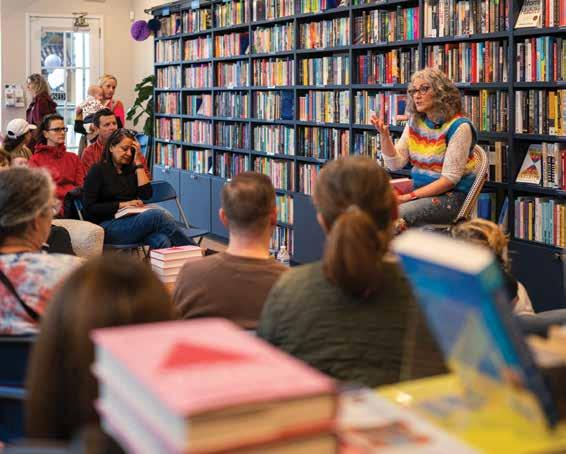
Tramontano. “I think part of the role of the neighborhood bookstore…is providing that level of curation for the audience,” Owens says. They have added and adjusted based on customer feedback, adding “a shelf for the anxious” and stocking more fantasy books as “fantasy has really boomed in the last year,” Owens explains. They also have authorcurated shelves by the likes of Kevin Kwan and Dani Shapiro, “because people want to know what people they respect want to read.”
The store hosts a packed calendar of author events and a monthly book club, which Owens says averages around 20 regular attendees. Owens’ “book-fluencer” status means Collins is not the only celebrity with a cameo at the store: actress and producer Reese Witherspoon has also put in an appearance, and former first lady of California Maria Shriver curated her own shelf of book recommendations. Other shelves feature the latest picks from celebrity book clubs, including Witherspoon’s, Oprah’s, and Jenna Bush Hager’s. Altogether, the store’s bookshelves feel like internet influence made tangible.
Zibby’s typically stocks the latest bestsellers, Owens says, since that’s what their customers often come in looking for—like Gabrielle Zevin’s Tomorrow and Tomorrow and Tomorrow and Bonnie Garmus’ Lessons in Chemistry. The store also highlights the output from Owens’ publishing company,
Zibby Books, whose spring publications include Amy Lin’s memoir about grief, Here After, and a family-relationships romp, Wedding Issues, by Elle Evans. Owens’ own debut novel, Blank—published by Amazon’s Little A—arrived in March, centering around a conceptual-publishing idea that was suggested by Owens’ son (and in the book, is suggested by the protagonist’s son). Eventually, everything in the Zibby Media world connects: the podcast and bookstore make cameo appearances in the novel, too.
Charlotte Johnson, the store’s assistant manager since its launch, says “the connection with the community” has been a mainstay for the business, including garnering regular customers who come in and share their thoughts on books and life. Johnson has noticed “how excited the people around Montana [Avenue] are to have a local bookstore,” she says. “People will just come in and thank us” for creating the local space, Owens adds.
“I hope that it adds on and continues to elevate the scene here. I think that [the scene] has only been rising in credibility and importance,” Owens says of the shop’s role in the L.A. literary world. “I think it has a younger brother to New York type of vibe, you know, always trying to catch up, but I feel like if I can help that and unite all the readers here, who are really looking for that point of connection and community, then what a joy.”
88

BOOKS BASED IN SANTA MONICA
Not only is Santa Monica a great place to find great books and read them (on the beach, in a bookshop or cafe), but it also happens to make for a great location for the stories told in their pages. Here now, a few selections of novels set in Santa Monica.
white boy shuffle
In Paul Beatty’s sharp, satirical coming-of-age novel, Gunnar Kaufman experiences the vast cultural differences between Santa Monica and the fictionalized LA neighborhood his family moves to.
a single man
Christopher Isherwood’s moving story about a man grappling with the loss of his partner takes place over one day in the Santa Monica Canyon. It has also been made into a Tom Ford movie starring Colin Firth.
the pleasure of my company
The novel by acclaimed comedian and actor Steve Martin follows an agoraphobic man who lives within the confines of his Santa Monica apartment, yearning to break free.
they shoot horses don ’ t they ?
A Depression-era dance marathon at the Santa Monica Pier brings together two struggling Angelenos in a harsh, existentialist tale written by Horace McCoy and adapted into an eponymous film starring Jane Fonda.
the lightning thief
The first installment of Percy Jackson’s popular young adult fantasy (and film) series about a young demigod on a heroic quest sees the Greek gods descend to Santa Monica beach for a battle.
Chef Chad Huff’s career path was mapped out for him early in life. A California native, Chad credits the state’s natural bounty and his mother’s tutelage in the kitchen, when he was young, as the spark that fired his passion for cooking.
“To my surprise and my mother’s delight, cooking came naturally to me,” Chef Huff reminisced.
Throughout his career, his training grounds were some of the most revered kitchens in the world. Huff graduated from Le Cordon Bleu College of Culinary Arts and sought out mentors close to his native California.
He learned butchery alongside Curtis Stone at Gwen. He studied the delicate complexity of seafood from Michael Cimarusti at Providence and the fine art of handmade pasta from Evan Funke at Felix. In fact, he became so enamored with crafting pasta,
he has the chemical compound for gluten tattooed on his forearm.
Now, as the Chef de Cuisine at Hotel Casa del Mar’s ocean-view Terrazza Restaurant, Chef Huff is excited to bring his Mediterranean-meetsCalifornia vision to Santa Monica Beach. Shopping locally as well as sourcing unique ingredients found only around the Mediterranean, he is blending the best of both regions.
Highlights include Hamachi Crudo, Spaghetti with Patagonia Shrimp Scampi, and Mediterranean Lubina.
“The California coastline provides us with the most incredible backdrop at Terrazza,” Huff says, gazing out at the sea. “When you pair that stunning view with crave-able dishes and attentive service, you can’t wait to return.”
Meet Terrazza chef Chad Huff.
Culinary Dreams Along the Coast
90
text by Armella Stepan

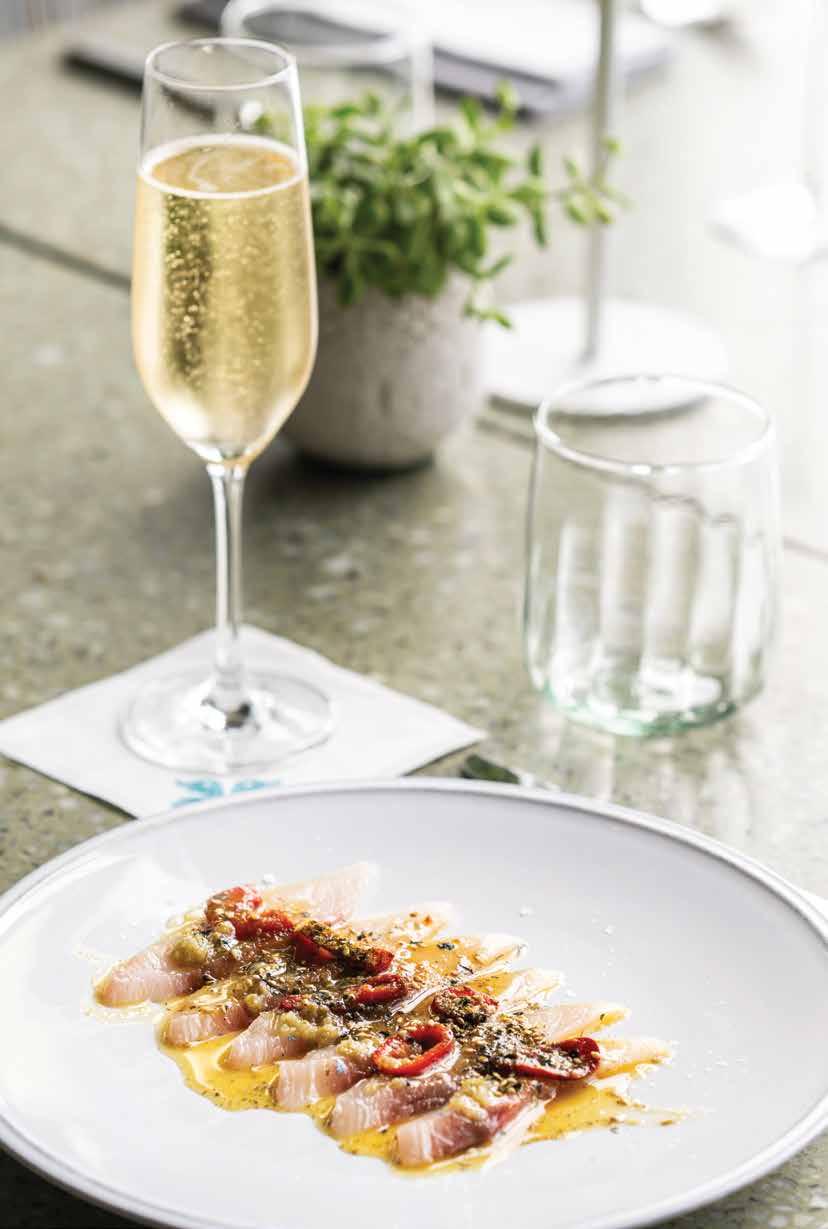

The spritz cocktail, with its effervescent charm, first journeyed from its Proseccorich birthplace of Veneto Italy in the 1800s to the picturesque resorts on the Amalfi Coast. This now classic aperitif has blossomed from a simple combination of white wine and sparkling water to numerous refreshing mashups, perfectly suited for seaside sipping on the California coast.
The key to a perfect spritz lies in its balance of flavors and the level of carbonation. Choices of mixers vary widely, however a dry prosecco is recommended. At Shutters on the Beach and Hotel Casa del Mar, each restaurant features its favorite, garnished with fresh herbs and produce from Santa Monica’s Farmers Market.
Saluti! Santé! Cheers!
HUGO SPRITZ AT SHUTTERS ON THE BEACH COURTYARD
Experience the essence of French elderflower with a Hugo Spritz in Shutters Courtyard or Living Room. The fragrant spritzes take center stage during the Shutters Spring Soirees.
A colorful Le Jardin by St. Germain comes alive in the Courtyard on Fridays, Saturdays and Sundays throughout the season of renewal. It is a vibrant celebration not to be missed.
St. Germain Hugo Spritzes take on a lovely pink hue during Rosé Month in June and Breast Cancer Awareness Month in October thanks to a dash of rosé!
Ingredients:
• Prosecco
• Soda water
• St-Germain Liqueur
• Fresh mint leaves
WATERMELON SPRITZ FROM COAST BEACH CAFÉ AND BAR AT SHUTTERS
For a sweet and fruity cocktail, order a Watermelon Spritz at Coast Beach Café. It’s perfect for watching the beach cruisers glide by on sunny days. A twist of lemon peel adds a bright finish to this delightful drink.
Ingredients:
• Aperol
• Vodka
• Rosé Prosecco
• Watermelon Juice and wedge
The now-classic aperitif is perfectly suited for seaside sipping.
Seaside Spritzes
ORCHARD SPRITZ AT TERRAZZA AT HOTEL CASA DEL MAR
Terrazza Restaurant and its adjacent Lobby Lounge celebrate the Orchard Spritz, a delightful fusion of floral and fruity flavors. Garnished with a slice of green apple this cocktail is perfect for a relaxing afternoon overlooking the ocean.
Ingredients:
• Lillet Blanc
• Sparkling apple cider
• Prosecco
• Green apple slice or thyme sprig
CLASSIC APEROL SPRITZ AT CASA’S PATIO DEL MAR
A classic Aperol Spritz at The Patio overlooking the Pacific Ocean transports you from Santa Monica Beach to the Amalfi Coast. Garnished with a slice of orange, this iconic cocktail offers a rich, citrusy twist.
Ingredients:
• Aperol
• Prosecco
• Soda water
• Orange slice
94
text by Armella Stepan

96

 Season Eight
Season Eight











 Left: Tiffany Howell, the Principal of design firm Night Palm, strikes a pose. Above: Howell’s “Lovers Rock” project in Los Feliz. Next Page: The living room at Lovers Rock. Images by Pablo Enriquez.
Left: Tiffany Howell, the Principal of design firm Night Palm, strikes a pose. Above: Howell’s “Lovers Rock” project in Los Feliz. Next Page: The living room at Lovers Rock. Images by Pablo Enriquez.




 Left: A playful couch sets the tone of a Woodland Hills home designed by Tyka Pryde Edwards. Above: Designer Tyka Pryde Edwards. Images by Tim Aukshunas.
Left: A playful couch sets the tone of a Woodland Hills home designed by Tyka Pryde Edwards. Above: Designer Tyka Pryde Edwards. Images by Tim Aukshunas.





 Above and right: The Millbank Home, then and now, located at 236 Adelaide Drive. The Craftsmanstyle home was commissioned in 1911 by wealthy Los Angeles resident, Isaac Milbank. It was designed by the Milwaukee Building Company. The home is a City of Santa Monica landmarked structure.
Above and right: The Millbank Home, then and now, located at 236 Adelaide Drive. The Craftsmanstyle home was commissioned in 1911 by wealthy Los Angeles resident, Isaac Milbank. It was designed by the Milwaukee Building Company. The home is a City of Santa Monica landmarked structure.


 Above and left. The famed Santa Monica Stairs, today and in 1978. The wooden stairs at 380 Entrada Drive in Santa Monica Canyon ascend to Adelaide Drive
Above and left. The famed Santa Monica Stairs, today and in 1978. The wooden stairs at 380 Entrada Drive in Santa Monica Canyon ascend to Adelaide Drive
 A 1920s Neo-Islamic style period home at 29 Latimer Road.
A 1920s Neo-Islamic style period home at 29 Latimer Road.












 Shirt and pant by Ferragamo, Shirt$1190; Pant - $990
Men’s GG Gucci Slides Sandal - $550.
Shirt and pant by Ferragamo, Shirt$1190; Pant - $990
Men’s GG Gucci Slides Sandal - $550.


 Right: Knit Missoni bikini - $590; White pinstripe Loewe blouse, $2100. Visor, blue clear Dior J’Adior - $225
Left: Dries Van Noten Tank - $520; Versace Chino shorts - $1125. Tory Burch bikini.
Right: Knit Missoni bikini - $590; White pinstripe Loewe blouse, $2100. Visor, blue clear Dior J’Adior - $225
Left: Dries Van Noten Tank - $520; Versace Chino shorts - $1125. Tory Burch bikini.




 Right: Mesh snap skirt by Issey Miyaki - Price NA; Knit Bralette by Jacquemus - $240
Right: Mesh snap skirt by Issey Miyaki - Price NA; Knit Bralette by Jacquemus - $240


 Left: Acne Studios Simon Fluid Horse Viscose Short - $550
Next page: Prada Re-Nylon Bermuda Shorts - $1200
Left: Acne Studios Simon Fluid Horse Viscose Short - $550
Next page: Prada Re-Nylon Bermuda Shorts - $1200












 The newest shop on the block, Divine Vintage, has brought a well-curated charm and popping patio scene to Montana Avenue with its unique combination of wine and vintage clothing.
The newest shop on the block, Divine Vintage, has brought a well-curated charm and popping patio scene to Montana Avenue with its unique combination of wine and vintage clothing.




 Above: Offhand Wine Bar opened in 2022 by Westside Winos, a group of friends, wine lovers and DJs. Left: Sommelier Nick Dumergue stocks the shelves of Divine Vintage, the spot he co-founded. Page 78 - 79, Divine Vintage.
Above: Offhand Wine Bar opened in 2022 by Westside Winos, a group of friends, wine lovers and DJs. Left: Sommelier Nick Dumergue stocks the shelves of Divine Vintage, the spot he co-founded. Page 78 - 79, Divine Vintage.









